#girls also get an art degree at a private institution
Explore tagged Tumblr posts
Text
girls say “im an artist” and then only draw headshots of their favorite characters
#im girls 😭#its a real problem#girls also get an art degree at a private institution#and still only draw headshots#artskls
2 notes
·
View notes
Text
Research: Project Finish
Tim Sale
Tim Sale is a famous comic book artist, who had worked in several titles along with the writer Jeff Loeb, including Batman, Spider-Man, Superman, Daredevil, and many others.
Tim Sale was born in may of 1956, in New York, where he studied visual arts, spent a good time of his life in Seattle, and today he lives in California.
For some years he drew his art privately, only to please himself. When he found himself working at a fast food in his late twenties, however, he decided to try to sell some of his work. This led to an association with Thives’ World Graphics, a fantasy anthology series, where he illustrated stories.
What most marks his work is the dramatic aspect that he manages to obtain in the characterization of his characters and in the scenarios he creates, making the stories unique and immortalizing the characters.
The union of Sale’s art with Loeb’s engaging narrative has become the perfect marriage for mysterious plots.
One of the most striking characters worked by Sale was Batman, which he drew “The Long Halloween”, “Dark Victory” and “Halloween”. He was able to fully transfigure the dark aura of Gotham and his Dark Knight. He also worked with Superman in the saga “ Superman for All Seasons”.
Both of The Long Halloween and For All Seasons are what is known as “Year one” comics. These works take their heroes back in time to their earliest days of crime fighters.
His main tool is watercolor, which he uses with mastery. Sale's palette of colors is something really impressive, always drawing and painting his characters very delicately, and calmly. His style is very cartoonish, although this does not diminish his art in any way, on the contrary, his style is very unique and characteristic.
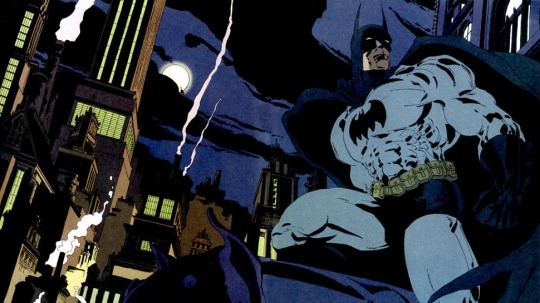
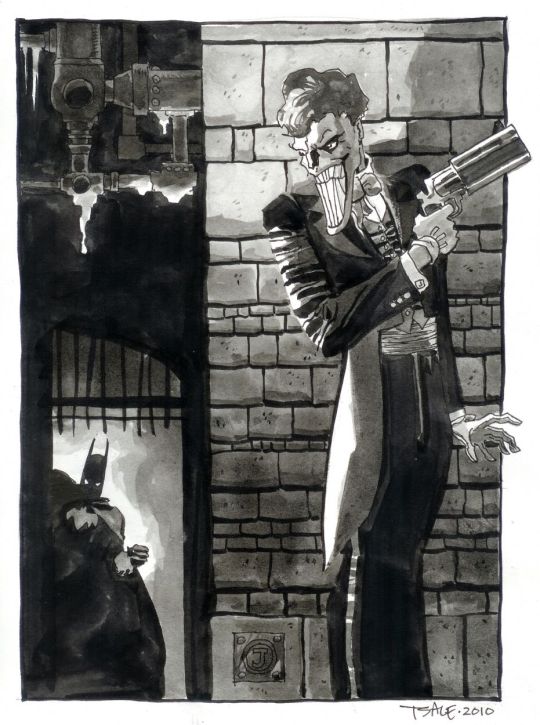


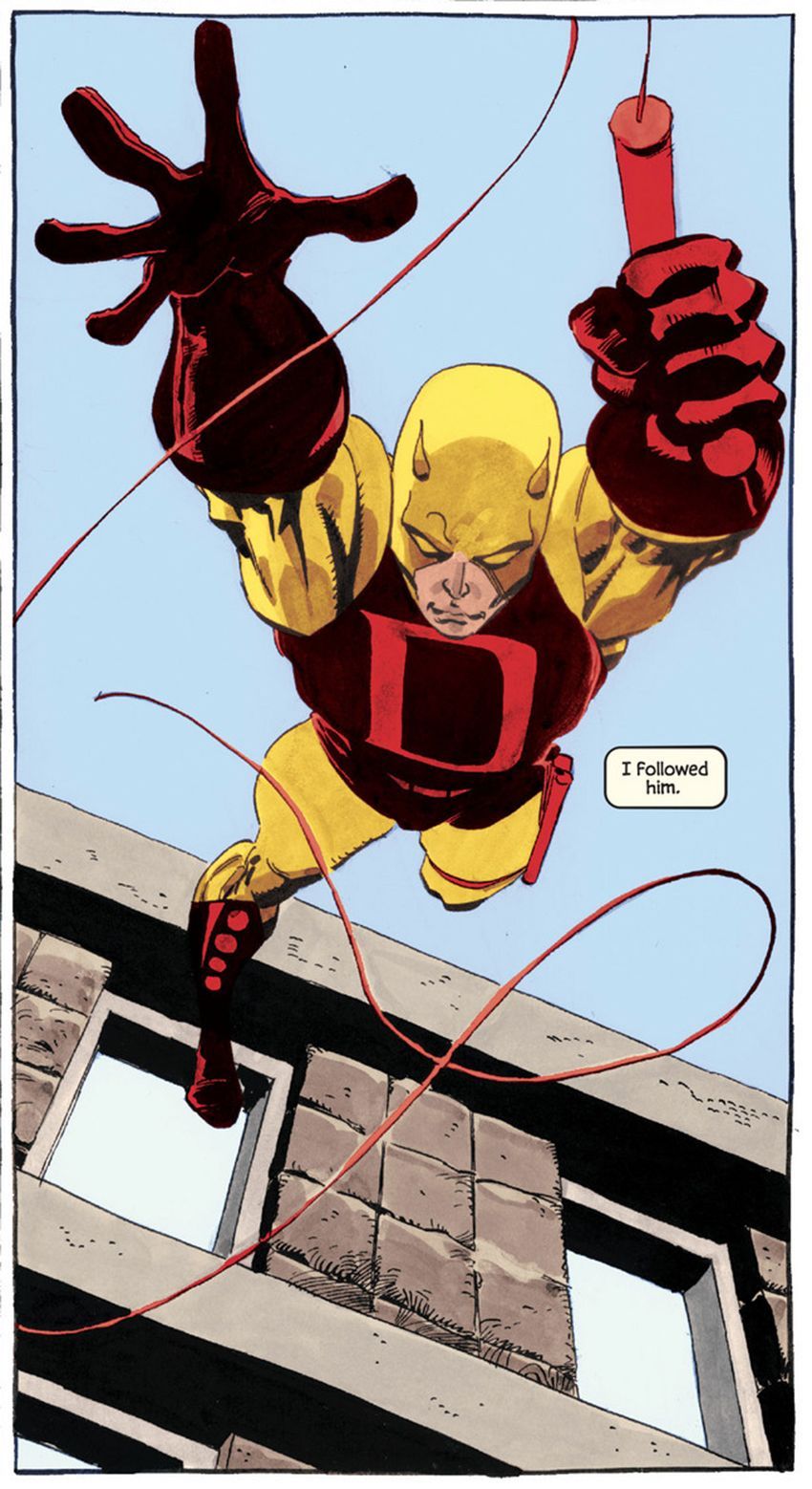
Pedro Franz
Is a Brazilian comic book artist, who was born in Santa Catarina and has a degree in design.
He has been publishing several comic books and participating in exhibitions in Brazil and abroad. As an illustrator, he has published works several magazines and books, and regularly collaborates with the Piauí magazine. As a graphic designer, he is a contributor to the Par (Ent) Esis platform. He has comics translated and published in English and Spanish, and has good international recognition, thanks to his publications.
But what is most impressive in Pedro's art, perhaps is his intensive use of colors. Mixing various shades of different colors, mixing different compositions. In addition to sometimes using characters from pop culture, with his elaborate style.
Despite liking traditional comics, he has always published and worked for national publishers, often with authorial works.
Perhaps his best known work, which was even published in the United States is the comic “Suburbia”.
Suburbia tells the story of Conceição, a girls daughter of enslaved rural workers, who flees to Rio de Janeiro in the early 1990s. In the city, Conceição begins to work as a cleaner and to get involved in the world of funk, slums and poverty.
His drawings are extremely surreal, not exactly following a traditional way of making comics, with several images spread across the page, with different shapes and sizes, with extremely strong colors, mainly valuing blue, purple, yellow and red, as his main colors.
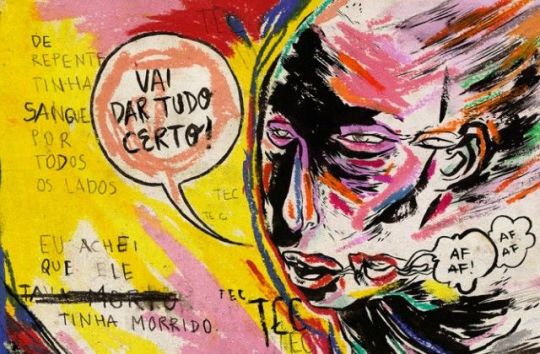
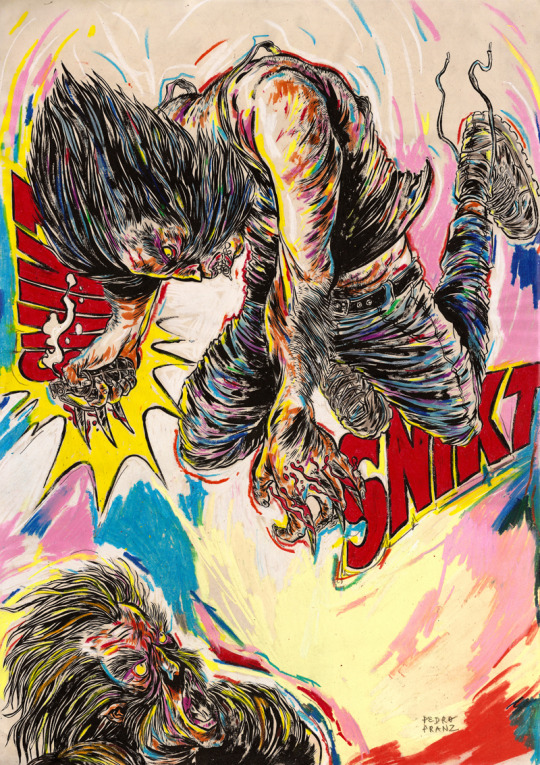
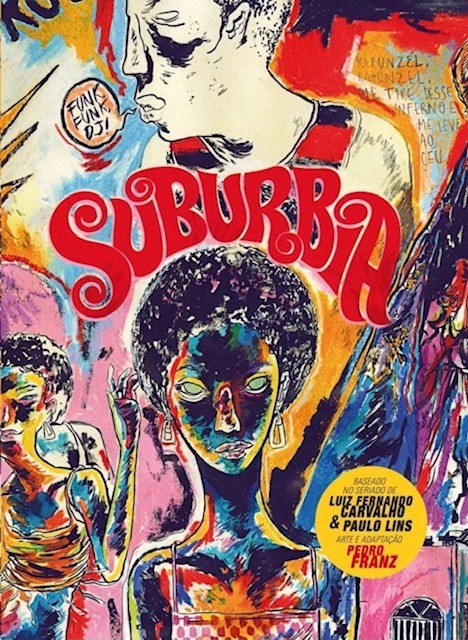
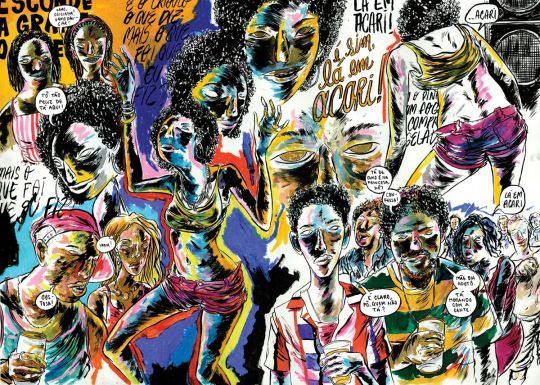
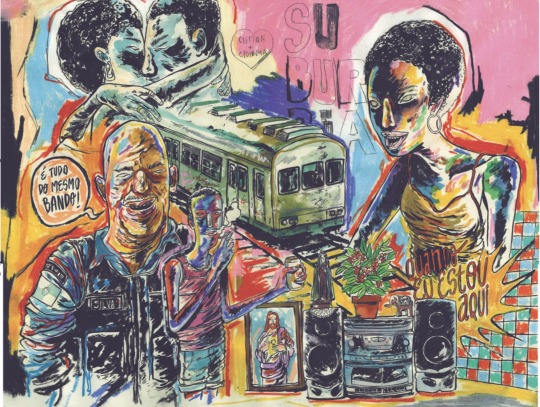
Richard Corben
Richard Corben was one of the contributors of elevating the comics to the category of Art, and of its unparalleled style of great influence among many current artists.
Richard Vance Corben was born in Missouri, United States on October 1940, in a family of farmers in the middle west ( where he started reading comics), and lived in Kansas City. There he studied Fine Arts, got married, had a girl and started working in local cinematography animation company. At the same time, he started to create and publish some underground fanzines. From the begging it was clear that he was interested in science fiction, eroticism, and total rejection of institutions ( the Army, the Church, etc), mixed with a lot of humor.
At a young age, Corben was an aficionado of bodybuilding, just like everyone who was interested in a persons aesthetics. The first character that he created, was Rowlf, a dog who took on a human form. In the beginning of the 1970s he amplified his work ( and his fame) in some underground magazines. And in 1971 he started working for the Heavy Metal publisher where he created one of his most famous characters, Den a large muscular man, who was always naked, and always after some adventure.
Corben has a very particular style, with unsettling mixture of caricatured, often satirical grotesque and intense,convincing realism. Never before had such wildly cartoonish worlds proved so convincing.
Also he can handle an exponentially higher standard because of his ability to use colour to show the effect of light on whatever he’s depicting. The way that he mixes light and colors in certain panels to differentiate those elements from each other, is something to admire.
Corben worked in a few mainstream comics, he always preferred to work with authorial works or working in specific themes like fantasy and science fiction comics and not so much on superheroes.
But probably the most famous mainstream comic that ever worked was the character Hellboy, along with writer Mike Mignola.
Hellboy is a series of comics that has a lot of mysticism, Norse mythology, horror and monsters. Something Corben certainly agreed to do, without thinking twice.
Richard Corben is one of my favorite artists, with a style that is perhaps not as realistic as an Alex Ross for example, but the humor and beauty that he puts in his characters is very unique.
Corben died on December 2, 2020, leaving a great legacy, for the world of comics and arts, with a very unique style and extremely stunning worlds.
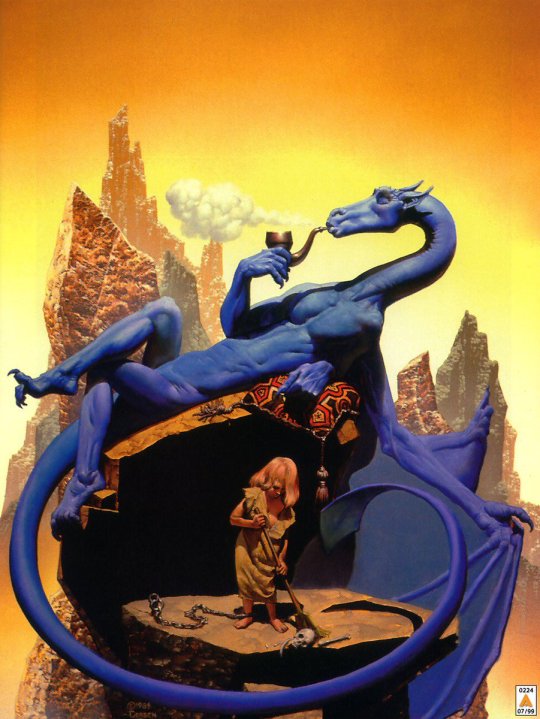
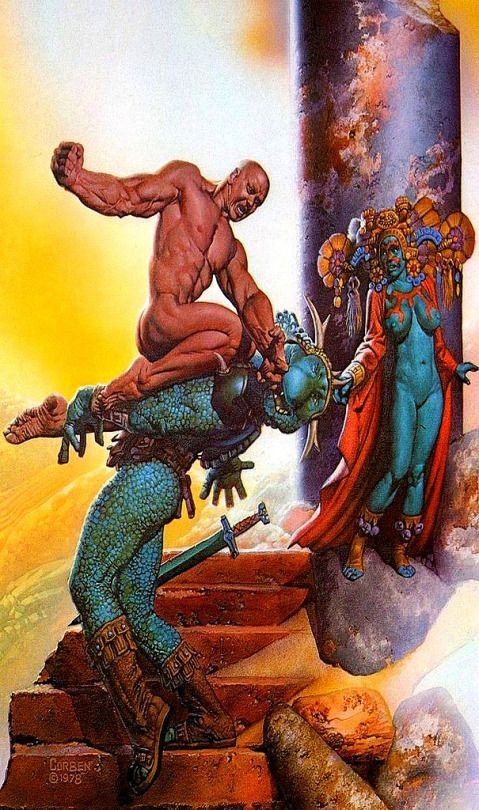
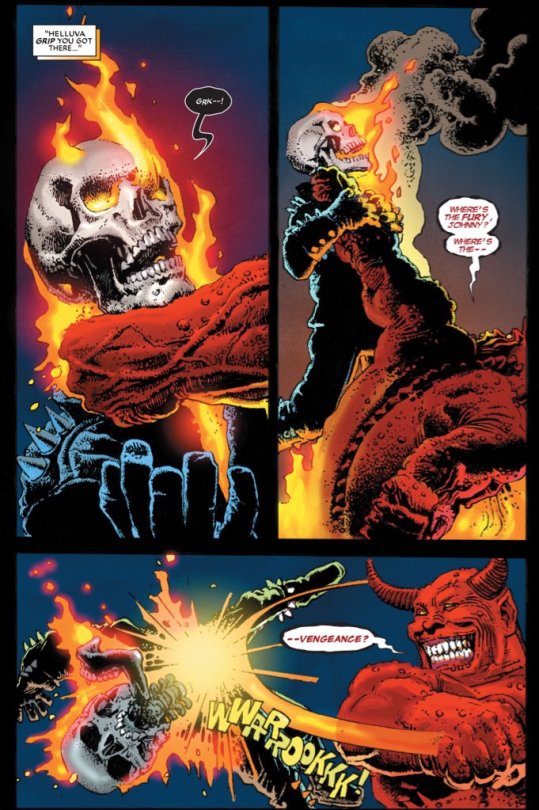
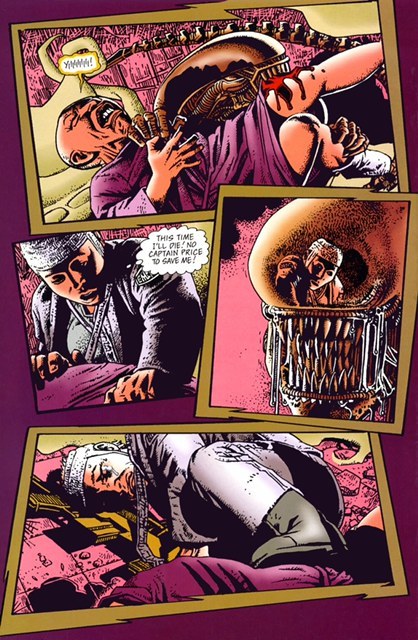
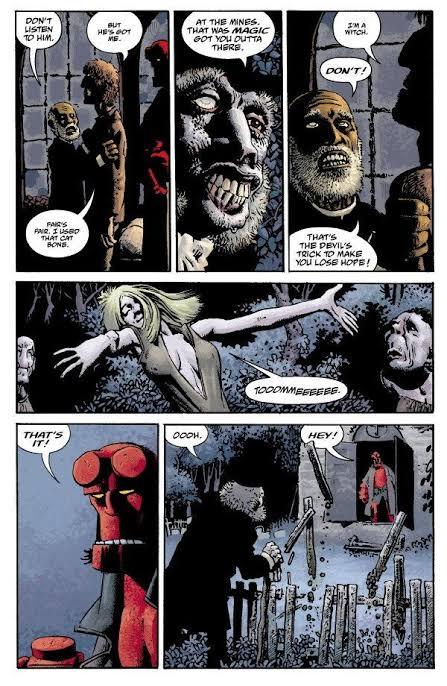
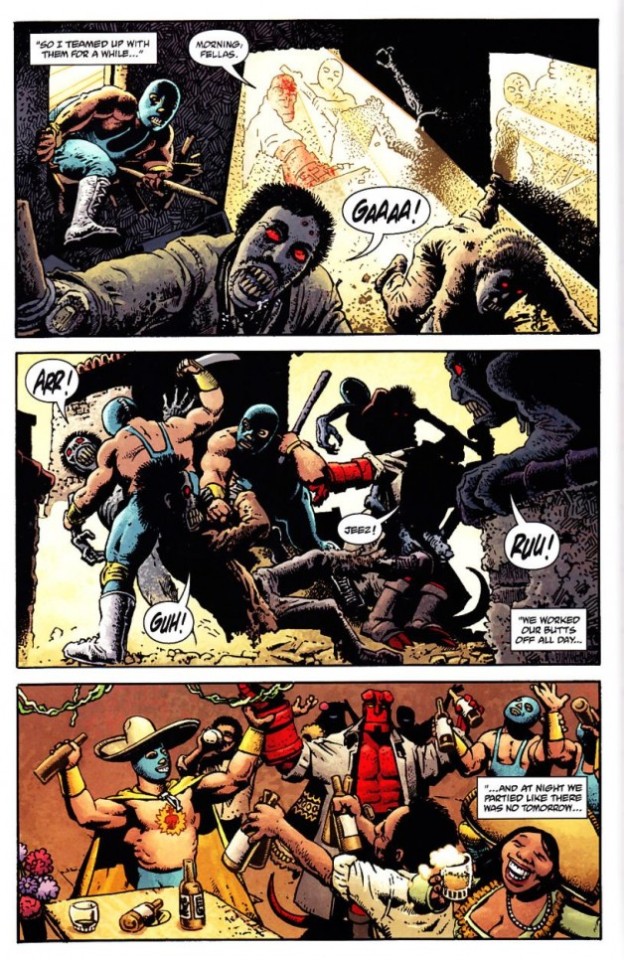
Charlie Allard
Charlie Adlard is a British comic book artist, who have worked on the comic industry for over 25 years. He spent the majority of his time since 2003 working in The Walking Dead along side with writer Robert Kirkman , until the last issue on 2019 He started reading comics when he was very young, and he said that he was very lucky to have influences of American comics and the more high art, such as Asterix and Tin Tin. He was fascinated by European comic books artists like Moebius, Alberto Uderzo and Herge. He started his career as many British artists and writers, working on 2000 AD, with characters such as Judge Dredd, Armitage and eventually Savage. In the United States he started working with the X Files, Astronauts in trouble, and of course The Walking Dead. Adlard started in The Walking Dead from issue 7, and brought a slightly different style, from the previous artist. Adlard's art is very cartoonish, but the universe of The Walking Dead still doesn't get silly because of it. Quite the opposite, the dirt and rot that Adlerd puts on his characters and the world, only sustains what a horrible world it is to live in. Many readers complain about Adlard's style, being very simple, that his characters are very similar, and sometimes it is difficult to identify them. But I believe that although his style does not vary much, when it comes time to show a horde of zombies, a devastated city, people feeling despair, and extremely disturbing scenes, Adlard manages to excel. Adlard's main tool is ink. All The Walking Dead magazines are in black and white, and he manages to give a lot of depth to the scenarios and characters using only a few ink stains. Today Adlard is doing some comics, mainly for DC, but says that he does not intend to work with Kirkman and zombies again, because he wants to explore other themes, and to innovate his drawing skills.
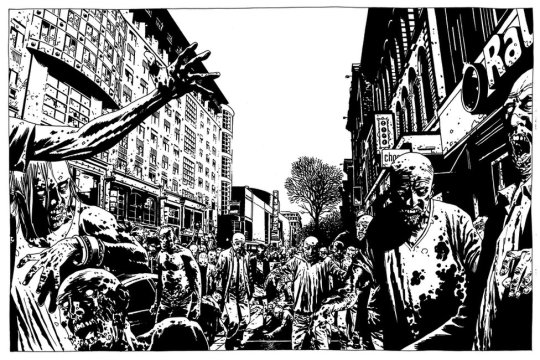
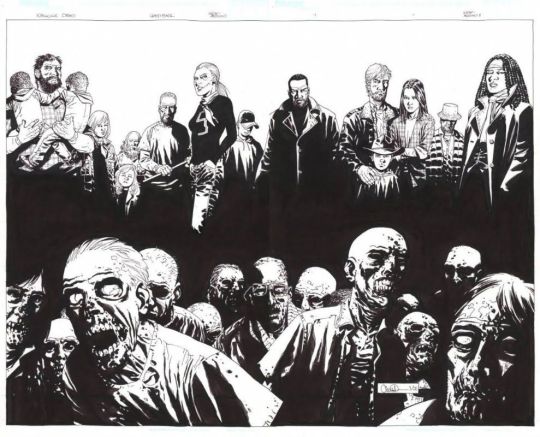
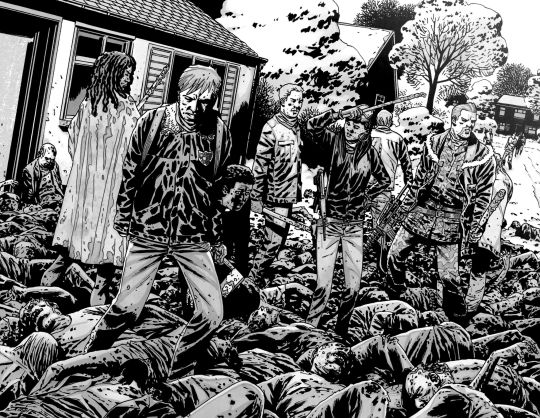

Zaha Hadid
Zaha Hadid was one of the most important and well known figures in contemporary architecture and design. With a singular trajectory, marked by a versatile, bold and out of the box style, she was the first woman to receive Pritzker Prize for architecture and was also the only female representative honored by the Royal Institute of British Architects with a golden medal. Zaha Hadid was born in Iraq, more precisely in the city of Halloween, in Bagdá, in the year 1950. Her family was of high class, her father being an important politician and her mother an artist. Still young, she traveled and studied in other places of the world, like London and Switzerland, but it was in her native land the she got her first formation, when she graduated in mathematics. At the age of 22, in 1972, she enrolled in one of the most famous independent schools of architecture in London, and there she gave the starting point to her career by studying and creating an important connection with the Dutch architect Rem Koolhaas, a figure that encouraged her and opened the doors for opportunities. Later in the 1980s, Zaha Hadid decided to open her own office. This, Zaha Hadid Architects was born, which made her name and talent recognized worldwide. Known for her works with futuristic lines, clean and pure forms, as well as the fragmentation of architectural design. Her projects and discussions raise issues that put architecture and its future to the test. This is because the architect seeks in her works to interrelate design, architecture and urbanism. I knew Hadid and some of her works, but it was the recommendation of my teacher Lauren, that I should look for this architect. As my project takes place in the future, she recommended that I look at some works by Zaha Hadid to get inspiration when creating the scenario for the comic. I find it very interesting how her works have this futuristic aesthetic , because it reminds me of science fiction films like Blade Runner with those skyscrapers and buildings with different shapes and sizes that are extremely imaginative that could only exist in films. With unique works and projects, famous for their exuberance, futuristic elements, curves, non linear shapes, distortions and fragmentations, Hadid inspired and generated fascination both for her constructions around the world.




Syd Mead
Syd Mead was a designer, best known for working on films such as Aliens, Blade Runner, Tron and Star trek. Mead was born in Minnesota, United States, on July of 1933, but five years later he moved to a second house in the western of United States prior to graduating from High School in Colorado in 1951. Some years later, he did the Art Center School in Los Angeles, where he graduated with great distinction in 1959. He was immediately recruited by the Ford Motor Company. At Ford he worked in the advanced styling department, creating futuristic concept car designs. But his imagination went beyond cars and he began to imagine clothes, helmets, buildings and scenery from hyper advanced civilization. After Ford, he also worked in other big companies like Chrysler, Sony and Phillips. After that he started migrating to the concept art world of movies. Mead is really important for generation of writers of science fiction, because many of them were influenced by Mead’s colorful paintings. Mead never wrote a novel or short story. He imagined the future in his mind and turned that imagination into illustrations. In 1979 he designed the extraterrestrial spaceship for the first film “Star Trek” in the cinema. Ridley Scott called Mead to design the buildings and flying cars of the futuristic Los Angeles “Blade Runner” in 1982. In 1986 he was hired to design the space station and vehicles of the movie Aliens directed by James Cameron. Almost at the same time, the designer created the electronic world of “Tron” for Disney studios. The same ones who hired him in 2014 to design the futuristic city of “Tomorrowland”. Mead died in 2019 after three years of lymphoma, he was 86 years old. He was a great influence for many designers and science fiction writers and illustrators, due for his creative worlds and automobiles , Elon Musk quotes Mead as one of his major influences, on visions of the automotive future and design in general.
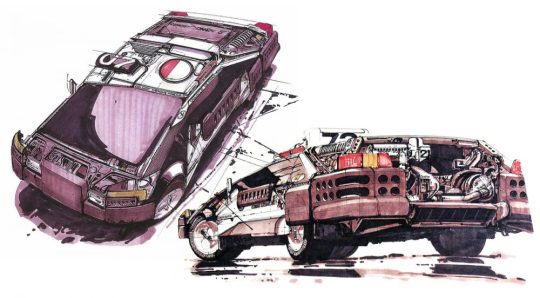
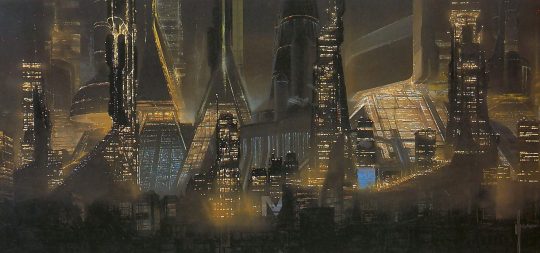
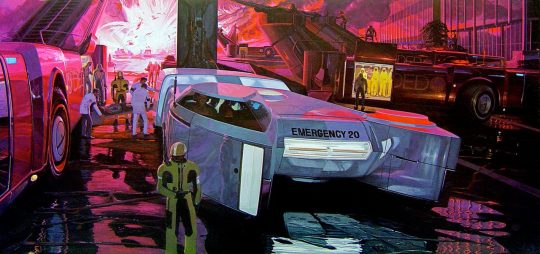
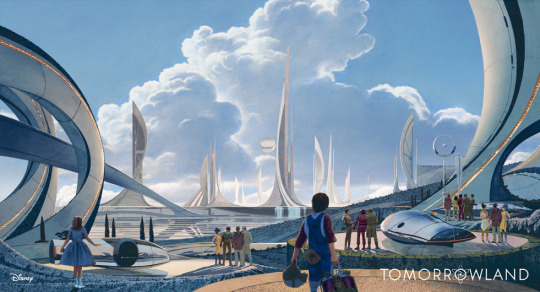
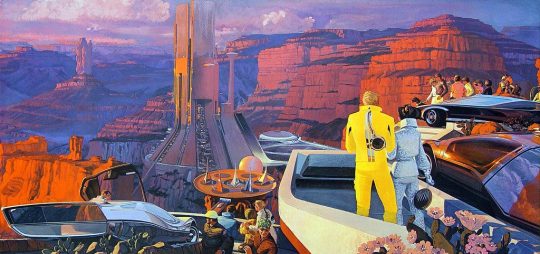
Transmetropolitan by Warren Ellis and Darick Robertson
Transmetropolitan is a comic written by the British writer Warren Ellis and the American illustrator Darick Robertson, published by the Vertigo label, and falls within the cyberpunk genre, and the problems that rampant technology will cause us.
Throughout the 60 issues of Transmetropolitan, Ellis and Robertson build a chaotic and brilliantly alive future, presenting a sci-fi society with a peculiar mix of elements of cyberpunk, political dystopias, bioengineering and transhumanism, sexuality, economics and much more.
In a dystopia, in a not so distant future, the journalist Spider Jerusalem is isolated for fiver years in a hut in the forest, but he has to return to the city to earn some money.
Throughout the comic, amid a nihilistic aura that humanity has no salvation, the author- Warren Ellis - criticizes the consumerism and futility. The illustrations, of Darick Robertson, is full of excesses as the environment should be, a brand of the style of the 1990s.
The search for the truth is the central theme of this work, and in the midst of all this we found ourselves in a investigative odyssey that involves the lowest scum of that society ( thieves, murderers and rapists) until reaches the highest of the scum ( the presidency).
This background allows the work to touch on the most profound social themes, and without fear of saying what needs to be criticized, this is where Transmetropolitan shines, and provoke deep reflections on issues such as racism, the influence of media, the power of religions, the education, and many other themes.
In short, Transmetropolitan dissects and criticizes everything, it points out the flaws, the lies and the hypocrisy of each one. It’s a study about the problems of democratic society in the 21th century.
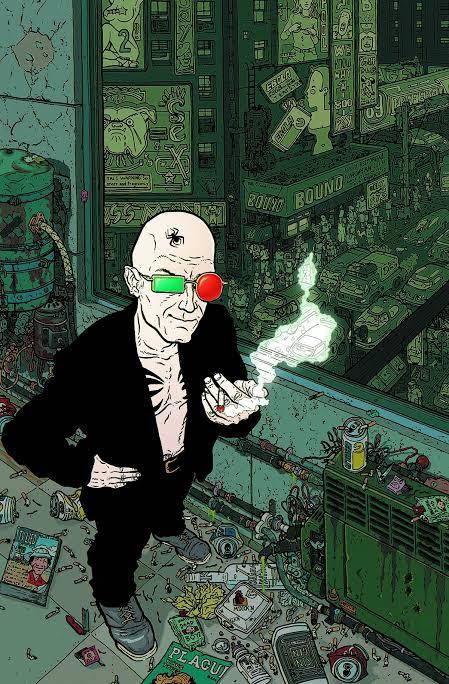
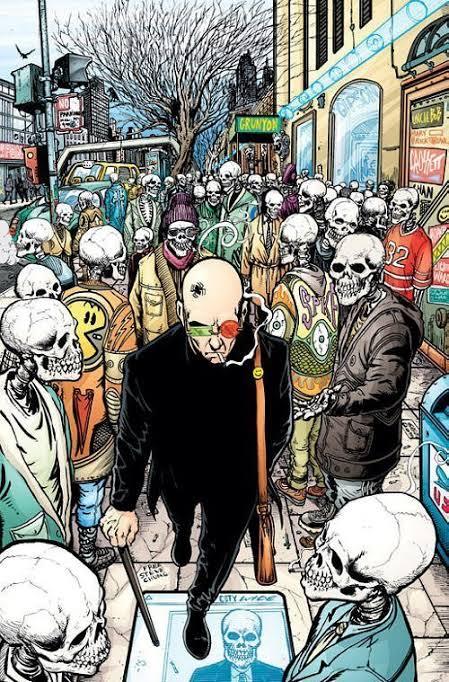
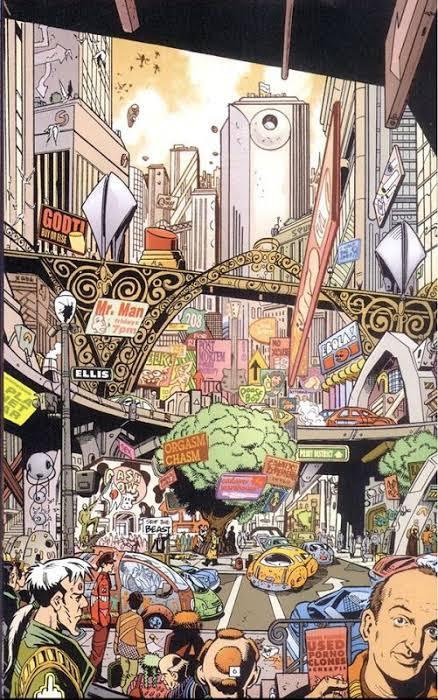


Jon Mcnaught
Jon Mcnaught was born in 1985, London, England. He work with drawing comics, and work as an illustrator, printmaker and lecturer. After spending several years on the Falkland Islands during his childhood, which will inspire his second book, Pebble island. The book pass years after the war, where he tries to recreate his childhood, with aspects of his curiosity, when he was exploring abandon bunkers, where it was just part of landscape, or somewhere where he could play. His work has essentially been landscape print-making (often situated in the city), but with quite simple intention of capturing the sense of space, light, time etc. His work is mostly about that, places that he was interested in depicting, and trying to reproduce the visual. He want the characters to feel like elements of a landscape or an environment ( he preferes to focus more on the background, than the characters itself). But usually he uses figures and postures to suggest expressions rather than close ups showing facial features. What I like about Mcnaught's work is that they are simple designs, but the colors are very vivid. The way he constructs the scenarios is very invective, because it doesn’t need to be extremely detailed, he just needs a few lines to show what he is talking about.
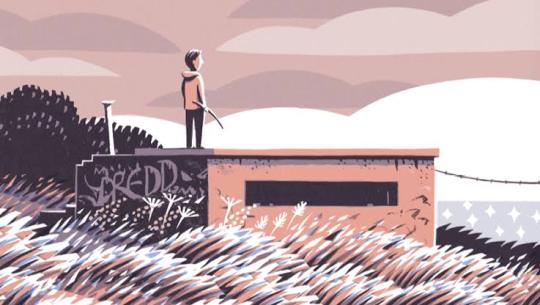
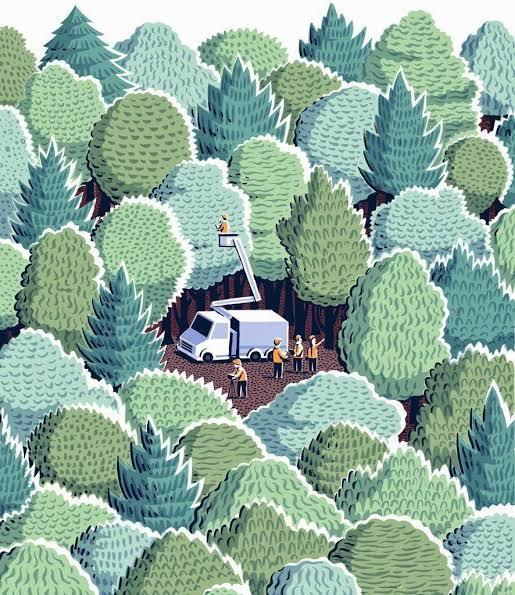


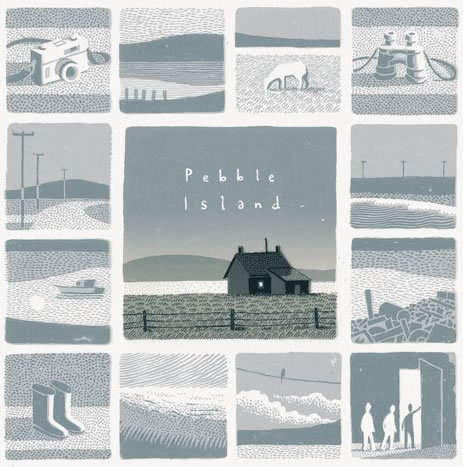
13 notes
·
View notes
Photo





For @himbosims Mathias Baron Bachelor Challenge
I wrote way too much,I’m so sorry...
Florence Robledo
27 / Renaissance Sim / Perfectionist - Snob - Ambitious / Board
Florence was born in Windenburg into a quite wealthy family. The father’s side of the family comes from Oasis Spring,and they’ve got a name in the upper part of Del Sol Valley’s Real Estate business. But their family prestige comes from the other half of it.They started off as a trading company back in the old days, and managed to claim their state into the high society of Windenburg. Sitting amongs the noble society didn’t happen without great sacrifices; they always say. Florence always could have anything he wanted,and so did his sibilings. He just needed to actually get to his parents first. That is because they were always busy and all of the kids went to study abroad. When teens years arrived, he was sent with his older brother,Demian, to a private all boys school in Brindleton Bay. Even if they were together far from home the two brothers didn’t really never bond. As Demian preferred to hang out with other boys more around his age, Florence built his own little circle of friendships. And before he knew it he couldn’t take his eyes off from one of his roommates. Which only meant big troubles.The school certainly didn’t approve and even less would his family. Also he was scared his roomate would find it despicable.So Florence kept it a secret, trying to keeping himself occupied by applying to the most classes he could. He didn’t want to let his parents down,always trying to please them was tiring but also it felt like that was the only thing he could do.Years passed and the pressure was too much, as he grew older he started to become somewhat of a troublemaker,first he would skip class,often talked back to anyone who said something to him and then sneaked out during the night; one time he even came back with a black eye. Around last year he would leave his room every night, coming back in the morning covered in marks. But high school quickly came to an end and he was faced again with his parents. His grandfather passed away that same year. Now even if the family were back together,Florence never felt more alone. Fear and pressure rushed over him and the desire to please his family, in hope it would make him feel a little more loved, came back too. His parents decided to enroll him into the distinguished degree of Art History in Britechester University, they had some acquaintances who could easily find him a job as soon as he finished uni. Actually art history was rather enjoyable and being far from his relatives meant he could relax a little more. Here he built some friendships, one of the boys in his friends group played soccer and during a match against the Foxbury Institute, Florence met a girl from Foxbury who would soon be his best friend. He still had an attitude,but was far more at peace. After graduating he moved out,and like his parents promised,they found him a job as an assistant of one of the most famous photographers in the big city, Simson Flash. The two of them didn’t get along,Florence wouldn’t stay in his place and spoke when he shouldn’t,or so the photographer said. But thankfully one of Simson’s associate was much more understanding, and was actually interested in hiring Florence as a museum curator. His new job worked out a lot better and he became a staple in the San Myshuno Musuem. He moved to the city with his university best friend and after having settled there he came out to his family,who didn’t take it well. They didn’t speak for a few years, but this time Florence didn’t need their approval anymore he had a group of people who supported him. When he made a name for himself in the artistic field they came back all smiles,but he wasn’t ready yet to forgive them.
Generally doesn’t have time for you, if you’re his friend he’ll try to be there tho
Can easly come off as pretentious but he’s not that much,just has a lot caffeine inside
Manners come first in his job but always have a snarky comeback if needed
Started to grey becaus of stress
Sleeps an average of 4 hours a night
Has a lot of pent up tension and that has to go somewhere…
Loves hickeys
He shares an apartment in san myshuno with his best friend. She’s known to throw great parties
Wanted to adopt a cat but his roomate is allergic
Will fight you to have the last word and will be grumpy if he doesn't succeed
His favorite food is Honeycomb Garden Vegetable Cups and his favorite drink is Simsmapolitan
Had a great relationship with his grandpa, who always told him how their family didn’t start as a trading company but as pirates. He was actually the first person he came out to, despite being a little surprised he was very accepting. But he suggested to keep it for himself until he was in a safe place and made sure that Florence would still be in his Will no matter what
20 notes
·
View notes
Note
Favorite movies/tv shows of 2019, and why? (Also, I really like your posts and hope you post more stuff!
Thanks so much! More posts are incoming. And sorry for taking so very long to answer this.
To be honest, I don’t watch a ton of contemporary stuff. I tend to think it’s healthier to take advantage of the great wealth of great art (or weird-but-interesting art) made in all time periods than to focus on keeping up with the present. Not that I don’t watch any contemporary things, I just don’t prioritize it in any way. So this list isn’t based on me watching everything and then picking out the best. It’s based on me watching a few things and liking some of them. But I hope that even if this list isn’t any more interesting than a list of awards ceremony nominations, I might at least have something worthwhile to say about the things in question.
Recent TV:
(I’m cheating and including TV from 2017-2019 that I watched in the last year or two, or else the list would be pretty boring and short.)
Succession (2018-present) - Maybe my favorite of the shows on this list, which is surprising to me because it’s not the kind of show I normally like. I don’t tend to care about rich people being mean to each other, or art that is glossily timely. I don’t get off on seeing the private dramas of powerful, immoral people. What I like about Succession is the sense of fragility and desperation that infuses it. It’s about the human desire for these stable institutions—families, kings, corporations—and whether or not they’re actually stable, and whether or not they should be destabilized. The whole thing is just a wonderfully rich text that has been made with a lot of craft. It’s nice to know that there are people making art that is very much about the present, and has something interesting to say about it.
Fleabag (2016-present) - The second season has gotten a lot of deserved praise, so I’m not going to dwell on its merits. It’s a complex and often moving exploration of the nature of love, whether romantic, familial, physical or divine. What makes it a truly “mature” artistic work is the way that it knows what it’s about from the very beginning (“this is a love story”) and complicates that aboutness in every single episode. It’s actually interesting to compare to the first season, which lacks the same maturity. The first season is still worth watching, but it doesn’t really become clear what it’s about until the last second, when Fleabag gives her monologue in the cafe. You keep waiting for it to get to the point, instead of having a repeated sense of anticipation about the point and accompanying satisfaction every time the point-shoe drops.
Killing Eve (2018-present) - Solid entertainment. Had a bit too much of the “contemporary TV aesthetic” for me to really love. But I’d missed genuine originality and clever writing in thriller-type stories. So it’s got that going for it. (Trying to actually define the “contemporary TV aesthetic” is a problem for another post).
unREAL (2015-2018) - I only watched the first season, and don’t feel a need to watch the rest. People tell me the subsequent seasons aren’t very good anyhow. But it was doing some interesting things. Things to do with femininity, authenticity, performance and love, and the degree to which they interfere with each other. I’m planning on talking about it a bit more in a subsequent post, along with Fleabag and the movie Weekend.
Sharp Objects (2018) - Mainly watched this and unREAL because I wrote so much about Buffy season six in the last year, and I was curious about Marti Noxon’s other shows (She was the main showrunner for that season, and you can definitely tell. Unhealthy relationships, mental illness in women, rough sex, and ideas of performance seem to show up in a lot of her stuff.). She has an interesting tendency to choose “trashy” subjects, but with a refreshingly non-cute approach to the (mostly-heterosexual) female id that I respond to. I keep trying to figure out what quality Sharp Objects had that other recent art about “women being and feeling fucked up in an artistically exaggerated way” didn’t have. Things like Midsommar, The Favourite, or Gone Girl. None of which I liked. And I think it comes down to that lack of cuteness. Watching a female protagonist furtively masturbate over the memory of a murder-shack in a way that’s not about fetishizing her? Either for a male or female or political audience? It’s weirdly satisfying.
Euphoria (2019-present) - Only watched the first four episodes or so, and probably won’t watch the rest. But it was interesting to me as a pretty successful attempt to be blatantly zeitgeisty. I like its vision of contemporary life as something full of hyperstimulus (“euphoria,” get it?). Whether that’s the hyperstimulus of porn, love, attention, validation, or actual drugs. It didn’t seem to be a reactionary condemnation of all of the above, more just a depiction of it, but since I didn’t watch the whole thing I can’t comment on its attitude with certainty.
The Vietnam War (2017) - Excellent Ken Burns as usual. I appreciated the variety of perspectives he interviewed, and I appreciated the episode dedicated to Vietnam’s history before the war started. If there’s one thing that American schools suck at teaching about the Vietnam War, it’s the Vietnamese side of things. I’m not a historian so I can’t comment on how good the history in the series is. I’m sure there are important criticisms to make of it, and like all Ken Burns documentaries he uses emotional tactics to tell the story that can at times feel manipulative in a bad way. But as someone who always wanted a more in-depth, multi-sided understanding of the Vietnam War, but didn’t know where to start, I was very glad to have watched it.
Black Sails (2014-2017) - Still haven’t seen the last season. But after watching I was honestly surprised I hadn’t heard more people talking about it. Or maybe that’s just my fault for not keeping up with mainstream writing about culture. It had some fascinating themes about the nature and fragility of civilization, and I think it would be interesting to compare to Succession on that front. Black Sails features characters on the outskirts of society. Whereas Succession features characters at the center of society. But both are about the desperation for stability that leads people to make societies—and disrupt societies—in the first place.
Recent movies:
(Sticking just to 2019 this time)
Once Upon a Time In Hollywood - What I liked about this movie is that it felt like a movie. I left it feeling like I’d had a big old cineplex experience. Which was fitting, because the movie itself was about the big artificiality of film. Throughout, there is this contrast between real violence, and movie violence, and who has an understanding of them. Cliff Booth, as a stuntperson, has a “real” relationship to violence, while Rick Dalton, as an actor, does not. Cliff can cut through a cult’s fakeness, and knows to turn aside an offer of underage sex. But although Dalton does not understand authenticity, he does understand fakeness. The point of the teenage terrorists in the final act is that none of them understand either authenticity or fakeness. They don’t get that violence is real, and they don’t get that movies are fake, which leads them to being destroyed by their own movie-inspired violence. In typical Tarantino form, the movie does have a smug-feeling nyah-nyah attitude about this theme, a feeling of “you idiot loser generation, you don’t get the seriousness of violence and you also don’t get that movies are fucking fun.” But it was a theme I found interesting nonetheless.
Apollo 11 - Unequivocally loved the cinematography. Just completely aesthetically compelling to me on every level. I would have have watched an entire Koyannisqatsi devoted to it. But I feel sort of weird saying that I liked Apollo 11 as an example of contemporary movie-making, since all of that footage I loved was shot in 1969. Still, the contemporary aspect—ie, the editing—did a good job as well. Mostly because it gave the impression of staying out of the way, even though it must have been a significant effort to select and organize the footage. As well as doing animations, titling, etc. I liked that the patriotism and mythology of it was mostly just conveyed via actual soundbites from the time. And that the competent chatter of scientists was given much greater weight. I watched Free Solo the other day, a climbing documentary from 2018, and I liked it for similar reasons—the fact that the presentation gave the impression of staying out of the way of the content, despite being obviously edited.
Parasite - Pretty understandable to me that it just won Best Picture, since it’s one of the few movies from the last year that knew exactly what it was about and how to do it, and did it with unpretentious panache. I appreciated its highly cinematic use of imagery. Say, the contrast between the concrete architecture on the upper and lower levels of society— how in the upper level it’s high art, and on the lower level it’s an inhumane prison. Or the way that characters keep visually crossing lines. I was actually pretty relieved to see that Joon-ho made this movie, because I hated Snowpiercer, and kept thinking it would have been a thousand times better if it was a thousand times less metaphorical and just depicted a real-world instance of inequality in a heightened, artistic way. Which is exactly what Parasite is. In fact, I think it would be interestingly instructive to explore why Parasite succeeded in creating iconic-feeling metaphors for social inequality where Snowpiercer failed. I also appreciated its basic vision of inequality as something symbiotic, and therefore systemic, rather than a matter of mere oppression. You find yourself asking more interesting questions about how to deal with systems when you acknowledge that systems are systems, even absurd and mutable systems, in the first place. Where I think Parasite was weakest was in the pace of the storytelling. I felt myself repeatedly getting ahead of it—eg, once you realize the brother is going to get the sister a job, you’re just waiting for the movie to finish up situating the mother and father as well. Whereas I think the strongest storytelling is perfectly aware of when the audience will start anticipating something, and uses that anticipation to create complications and surprise.
An incomplete list of some other things I watched in 2019 below the cut…
Movies that I watched for the first time and liked a lot:
Brink of Life (1958), Abigail’s Party (1977), Vigil (1984), Dog Day Afternoon (1975), Resolution (2012) / The Endless (2017), Jungle Fever (1991), Festen (1998)
Movies I saw for the first time that did things I found interesting:
The Devil’s Playground (1976), Skin Game (1971), The Reflecting Skin (1990), Straight Time (1978), Late Spring (1949), Iceman (1984), Hideous Kinky (1998), Bad Company (1972), Gozu (2003), Spring (2014), Jamón Jamón (1992), eXistenZ (1999), Bull Durham (1988), Carrie (1976), Swiss Army Man (2016), Tully (2018)
Movies I saw for the first time that I’d have to write specific pros and cons for:
Cape Fear (1991), Fury (2014), Cruel Intentions (1999), White Men Can’t Jump (1992), Spiderman: Into The Spiderverse (2018), The Deer Hunter (1978), Jennifer’s Body (2009), It (2017), The Favourite (2018)
Movies I rewatched and still loved:
Night of the Living Dead (1968), Dawn of the Dead (1978), The Ring (2002), Do The Right Thing (1989), F for Fake (1973), Tampopo (1985), Girl With The Dragon Tattoo (2011), Broadcast News (1987), Tangerine (2015), Weekend (2011), Conspiracy (2001), Bicycle Thieves (1948), The Devil Wears Prada (2006), The Thing (1982), Who’s Afraid of Virginia Woolf (1966), The Hunger Games series (2012-2015)
Movies I rewatched and didn’t like as much:
Clue (1985), Before Midnight (2013), Vertigo (1958), Anchorman (2004)
16 notes
·
View notes
Text

hello all you lovely lovely people ! thanks again for applying to this rp, you have NO idea how excited i am to get this going. i’m lily, i’m newly 20, in the est timezone and my pronouns are she/her. i love trash tv, my puppies, and the collected works of the greatest band in history (one direction). this is my trash daughter frankie, she truly belongs in the garbage but i love her so much. below the cut is my long ass intro for her, i forgive you if you don’t read it all because looking at it now i wouldn’t want to either ! anyway, if you’re interested in plotting with me and frankie, hmu on discord and you can check this blog for some connections i would love to see !
( alisha boe, cisfemale, she/her, MUSE E ) — oh my god, i totally just saw FRANCESCA ARCHER walking through greenwich village! you know, she plays SKYLAR ELLIS on that new netflix show, the village? i can’t believe they’re already famous at TWENTY-ONE. i’ve watched all of their interviews, and they totally come off as IMPERTINENT and RECKLESS, but they can also be ROMANTIC and WITTY. based on their social media, i’d describe FRANKIE like ( worn out black high-tops, mischievous smiles, nails painted different colors, peach vodka, swimming in an ocean during a storm ) — totally makes sense that people call them THE SPITFIRE.
important links: bio. statistics. filmography. muse posts. social media.
warning: death tw on the 5th bullet point!!
the frankie archer story begins in 1996, when her mother yasmiin moves from her home of somalia to brooklyn to pursue an art career. she moved into a tiny apartment halfway across the world, knowing nothing and no one, looking for inspiration. she found it in the form of lorenzo archer, her next door neighbor. they dated for two years, but neither family approved of the other as a match: yasmiin’s family wanted her to return to somalia, and lorenzo’s roman catholic family were not pleased about their son selecting a non-catholic woman. but lorenzo and yasmiin didn’t care, and got married at new york city hall with the court appointed witness. two weeks later, yasmiin was pregnant with frankie.
francesca simone archer was born on june 9, 1999. she is a gemini sun, a scorpio moon, and an aries rising. she was named francesca for her grandmother on the paternal side, and simone after nina simone, the singer that was playing on lorenzo’s record player when they first met. her two siblings, nala archer and zahi archer, were born in 2001 and 2003 respectively.
her childhood is generally quite happy. lorenzo and yasmiin were born to be parents and they love frankie, nala, and zahi endlessly, the type of supportive love that makes children thrive. frankie possesses a natural wit and excels academically, nala is the star athlete, and zahi is a wizard with watercolor. frankie loves the movies and decides she wants to be an actress when she grows up, so lorenzo and yasmiin enroll her in acting classes and improv camps. things chug along in the archer family beautifully.
that is, until frankie gets a high school scholarship to packer collegiate institute, located in the affluent neighborhood of brooklyn heights. she takes it, of course, with her parents’ full support. but she is nothing like anyone else who attends packer, and for a 14 year old who wants to blend in, that is the worst possible thing. she is suddenly, painfully aware of her worn-out clothes, her used books, her strange mother with paint stains on her bleached out jeans. frankie lashes out, screaming and storming off and slamming doors. she and her mother are hurricanes and the rest of the family simply battens down the hatches. one day when frankie is 15, she tells her mother that this family is her worst nightmare. it is the last words she will ever speak to her mother.
a few hours after, the archers get a call that yasmiin has been in an accident. it was a hit and run: a drunk driver t-boned her, and they’re rushing her to the hospital. when the family arrives, the doctors break the news that yasmiin is comatose and that things aren’t looking good. lorenzo refuses to take her off life support, insisting she’ll recover. she is in a coma for nearly a year and a half before he is convinced to pull the plug.
and now, the part of the frankie archer story that everyone knows, the serendipitous hollywood beginning. she’s just a charming, talented, grieving, all-american girl from brooklyn, heading off to juilliard in the fall. on her 18th birthday, the first one spent without her mother, she attends an open call for a role in an indie film called thursday mourning. she thinks it’ll be a fun way to spend the day, or at least distracting enough. and then she gets the fucking part.
long story short, the film blows up. it’s shown at venice, winning the golden lion and a prize for frankie as the most promising young actor in the festival. it’s nominated for four oscars, including a best supporting actress nom for frankie. she doesn’t win, but it’s created a path for her to do whatever she wants, acting-wise. she does three more films in the next two years, gaining a reputation as an indie darling before realizing that indie films don’t make all that much money.
and she needs money, because her father is drowning in hospital bills from yasmiin’s death that he can’t pay. that’s when the offer comes through from her agent: a starring role in an ensemble cast netflix show called the village. she’s planning on throwing the script away. she’s not interested in any television show, much less a teen drama. she’s a serious actress and she certainly doesn’t want to be the next veronica lodge, made fun of on the internet by strangers with discerning taste. but with a little coaxing from her agent, she reads the script, and the role is good, the writing strong. so she takes the village, even though she wants to do movies more, even though she might get memed into oblivion. one episode will halve her father’s debt.
frankie was tapped for the village because while she’s definitely not as famous as some of her other castmates, nor does she have the hollywood background, she has consistently received acclaim for her performances. the producers think it will bring them some clout with the critics, and she has a sterling reputation as a hard worker on set.
so that’s the basic bio of frankie! now onto her personality >:-)
first of all, and most importantly, if you call her francesca you are DEAD.
frankie’s described by the media as a spitfire, and she definitely lives up to that description. she’s not particularly patient with interviews or paparazzi, she has a nasty mouth and an acerbic sense of humor, and to the general public she probably comes across as quite guarded and private about her life. she got into this business to be an actress, not a celebrity.
nevertheless, if she wanted to be a celebrity, she could probably be a pretty beloved one. frankie has a very charismatic, charming way about her, that probably lets her get away with more in the public eye than she should. there’s just something about that hollywood story that makes people relate to her and root for her.
the number one defining characteristic of frankie is her passion. she throws herself intensely into everything she does, feels emotions too vividly, fights for what she wants. she cares so much about everything. acting is her main passion, her forever love. it’s why she’s so good at what she does: she’s not the most talented, she doesn’t have the most training, but she feels so intensely. it also makes her very emotional (classic cancer!) if you’re close with her
also because of this passion, she’s probably the most competitive person you’ll ever meet in your entire life. she’s like, slightly insane about it? she wants to win everything, but she hates losing even more than she likes winning. she’s the type to throw a tiny tantrum if she loses a game of uno.
frankie’s always been bold, likes to live life on the edge, but it became something much uglier after her mother’s death. she’s reckless to the nth degree: doing her own stunts, drinking and partying the night away. she’s not suicidal, but in some ways, it’s like she doesn’t have a huge regard for her own life.
in her private life, frankie is pretty different. it’s not so much that her negative qualities disappear -- she still swears like a sailor and is less than patient. but rather, the flaws become less apparent when you get to know her. she’s sort of a goofy little marshmallow wearing a giant suit of spiky armor.
one of the most loyal people you will ever meet, because she throws herself headlong into friendships and relationships. she’s sort of an all or nothing type gal, so if you befriend frankie expect it to be a very close relationship whether you like it or not.
she is kind of the crazy friend? she’s baby? like she’s absolutely the person who’s encouraging everyone else to do dumb shit, and she’s always coming up with ridiculous ideas and pranks. side note give frankie a prank buddy on set!
she’s really quite witty. she absolutely loves twitter, which is basically the only glimpse the general public would get as to who frankie is in private. her twitter filled with her dumb jokes and random thoughts. in another life, she might have been a twitter comic.
she is a hopeless romantic, which she will never admit to anyone in the world unless it’s layered under 100 miles of sarcasm. the only relationship she’s really ever known is her parents’ relationship, and they were madly in love til the bitter end. she desperately wants something like that, but hasn’t quite found it. she’s been in exactly one pr relationship, but nothing particularly real or long-lasting.
she loves fashion. her mother taught her to sew and she sketches and makes some of her own clothes. her absolute dream is to collab with a designer on a fashion line: some of her favorite labels are marc jacobs, jean paul-gaultier, sies marjan, and moschino! she’s also had a lot of positive press for her red carpet looks.
she has a dog, who she loves more than anything! his name is duke, he’s a staffie rescue, and she brings him on set frequently. she’s lobbying to get him cast as someone’s dog.
she’s playing skylar ellis on the village, and because this is literally so long you can find some info about skylar at these links: statistics, muse posts, social media. i haven’t finished writing her entire bio yet but here’s the rundown: skylar appears to everyone like the pretty princess who has everything she could ever want. her parents are rich, she’s beautiful and smart, and she has a perfect relationship with phillip. but on the inside, she’s drowning. her dad wants her to take over the family company but she wants to be a writer, and the worst part is that she’s good at writing and horrible at business! she’s always been content to go with the flow (aka, what her parents want) because things are good in her life, but after her encounter with james over the summer, she’s realizing that she is completely trapped in a life she doesn’t want in the least. now she’s a conflicted mess of emotion trying to figure out what to do.
6 notes
·
View notes
Photo
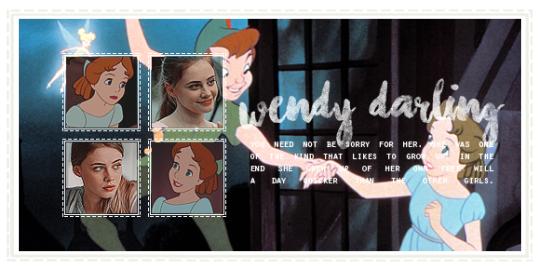
✦ — [ josephine langford. 22. she/her. peter pan ] WENDY DARLING was just spotted coming out from the LIBRARY, with ALESSIA CARA, SEVENTEEN; playing as a constant tune inside their head, it might as well be their song. easily noticed by their DELICATE BLUE RIBBONS, HAIR TUCKED BEHIND THE EAR, & WIDE DOE EYES. WENDY is not one to be forgotten.

✦ — what are you keeping from the original canon
i’m keeping a majority of the canon information that you get at the beginning of the movie - wendy comes from an upper middle class family from london, where she lives in a fairly respectable home in bloomsbury with her two younger brothers, her parents, and their family dog, nana. the family has a decent amount of wealth and privilege and as a result she grew up with pretty firm expectations of what a ‘ respectable lady ‘ looked like
also similar to the movie, she was pushed into a maternal role in raising her two younger brothers from a young age, and due to the fact their parents were constantly out at various work events and charity functions, she had a heavy hand in looking after them. i’d imagine they’d still be quite close, but from wendy’s side at least there’s always that barrier of feeling like a parent not just a friend or sibling
i think the main place her backstory would differ from the movie is in the lack of visit from peter pan and adventure to neverland - that was kind of the one thing that helped her cling to that love of stories and childhood whimsy and not wanting to grow up, and without that happening she much more quickly caved to the pressures from her father to grow up and abandon frivolous pursuits. this modern day wendy is a lot less inclined to dreaming and flights of fancy
✦ — personality
squeaky clean, bright eyed bushy tailed girl next door. in general just gives off the clean cut aura of the perfect all american girl ( or i guess in this case british girl? ) – sweet and innocent and golden. her parents raised her incredibly well, to the point they were almost forcefully overbearing, and that polite demeanor definitely shows
as the eldest and only daughter, her parents were very preoccupied with raising her to be mature and responsible and grown up, and to help take care of her younger siblings. she really took this to heart, and as a result can come across as a little ( a lot ) uptight. she’s lowkey way too formal even in everyday life and holds herself very prim, very proper. manners on point ( read: looks like she’s never had a day of fun in her entire life ). everything is about presenting herself as capable and respectable and perfect, and while she means well, she can come across as a little judgmental. she would probably rather jump off a cliff than break the rules or do anything remotely risky like … ever
to go with this, she’s also probably a little naïve. circumstance has left her pretty sheltered – the definition of book smart with 0 street smarts. experience outside her own very structured and suffocating upbringing has been fairly limited, and i don’t even think she recognizes how naïve she really is, she’s definitely the type that thinks she knows everything and yet could easily get fooled in 2 seconds flat. very mom who thinks they know best, sometimes condescending without intending or realizing
however, as much as her family has tried to squash and mold her into more practical and respectable pursuits, she does retain an almost lifelong love and appreciation for storytelling and the fantastical. beneath her more stern and buttoned up persona, there’s more whimsy and imagination than you would probably expect, it just needs to be teased out. i think that’s something she’s grappling with - her more innate dreaming side versus the mature expectations being thrust upon her
i just really want to play on scenes from the movie like when peter is trying to get her to come to neverland and she’s all “ but i need to pack! i need to leave a note! i need to do x y z !! ” or when the mermaids are teasing her and she gets all indignant and stuffy. or even when all the lost boys are jumping here there and everywhere and she just plops down in the middle, entirely unwilling to participate. just that tight laced inability to let go
+ mature, maternal, poised, eloquent, responsible, meticulous, organized, rule abiding, kind, imaginative
- uptight, perfectionist, sheltered, naïve, stubborn, judgmental, self critical, pretentious
✦ — your characters schooling
currently wendy’s major is education, which her parents strongly advocated for. she enjoys it to an extent - there is something to be said for sharing the things she enjoys with a new generation, and she’s quite good at it teaching, if she does say so herself ( all those years looking after her siblings paid off ) she could see herself being content with that. but her true passion is really creative writing and fantasy literature; the only reason she’s not pursuing it is that she’s been told time and time again by her parents that it’s not a useful or adult degree and that she needs to pursue something more practical and mature. she does still try to take as many literature electives as possible, though, despite this
she’s an okay student, fairly clever but not overwhelmingly naturally gifted, but she’s incredibly earnest and tries to make up for it through hard work and dedication
wendy’s also involved in a fair amount of extra circular activities - again, at the urging of her parents. a lady must be well rounded, after all. student council, tutoring, and orchestra are all things i can see her being involved in. she probably also pops her head into the book club when she get’s the chance, more for her own enjoyment than any perceived obligation. she is a BUSY lady
i can def see her being roomed in welbeck manor because her parents are afraid of the co ed dorms haha and are convinced it’s the more respectable option
✦ — two connections
( JOSEPHINE LANGFORD ) our WENDY DARLING is looking for JOHN DARLING to fulfill their YOUNGER BROTHER. They would be <22 and would most likely look like UTP. You DO NOT have to contact the player. @hvnriks. description: i would love for this to be a fairly close relationship, at least outwardly, but that carries maybe an underlying tension between them ? wendy loves her brother, of course she does, she literally helped raise him, but i think she may hold some jealousy or bitterness under the surface for the expectations that she was forced into as the oldest and the mother role she was expected to fill while he got off a little more scot-free
( JOSEPHINE LANGFORD ) our WENDY DARLING is looking for PETER PAN to fulfill their BAD INFLUENCE. They would be UTP and would most likely look like UTP. You DO NOT have to contact the player. @hvnriks. description: i just really love that dynamic of good girl responsible wendy trying her damn best to be a grown up and peter crashing in there and ruining it all. there’s definitely a part of her that wants to rebel and experience all the things she never got to so i can see her very easily being lead into bad decisions, no matter how much she may complain about peter’s so called immaturity. or even getting her heart broken if that’s a route we wanted to go
✦ — three head canons
definitely the proper little lady in more than just demeanor - wendy went to an all girls private school growing up, as well as was educated in a lot of the more formal arts, such as ballet and violin and even etiquette. her parents were very dedicated to raising her as a ‘well rounded and well adjusted young lady ’, for better or for worse. ( they’re also the ones that basically picked sherwood for her on the basis that it was a highly respected institution with a good reputation ) she’s also picked up a lot of the more homely skills, such as cooking and sewing and the like, as a result of looking after her brothers and filling in as an almost second parent
has 100% never dated or even really had a crush on anybody. absolutely naïve and misinformed about the perils of romance and going to get taken advantage of
dresses a little … stuffy. a little boring. for all that she’s actually quite adept at sewing, she tends towards the safe options. a lot of soft cardigans and peter pan collars ( ha ) and plaid skirts in soft colours. just another facet of her proper british lady persona that i don’t think she’s even crafting intentionally. just exactly how you would imagine a good private school girl to dress
1 note
·
View note
Text
At First Glance Ch. 4: The Commencement 👩🏽🎓
A/N: It’s finally here! The end of At First Glance has arrived and I have to say, I’m a bit emotional about ending my first series 😭. Thank you guys for supporting At First Glance these past few months. I have another series in development and then hopefully I’ll actually think about the wedding series. But for now, enjoy our fave couple in this series finale!
Word Count: ~3.2k
Warning(s): Black Excellence, Black Love, Smut (FINALLY!)

Saturday, December 7, 2013. 11:06 a.m.
Woolsey Hall, Yale University
At just 23, Yaa was the youngest recipient of a doctorate in African Studies. She was also a joint PhD-JD student that became the valedictorian of both classes (she earned her JD in May), which as you imagine, is almost unheard of, ESPECIALLY at a prestigious institution such as Yale.
Of all the people proud of her accomplishments, Winston was undoubtedly the happiest. She was the smartest person he’d ever met by a long shot. Not only was she smart as hell, but she was also gorgeous and had enough personality for seven people. Bonus points for Winston. As a fellow Yale grad, Winston enjoyed the return to New Haven. Amid all the celebration, Yaa and her family were meeting Winston’s mom and sister today. Whew chile, the celebrations. Winston and his family found Yaa’s family, Tanisha, Kimya, and Daveon (AKA the Yalemigos, or the Migos) all sitting in the same area.
“Mr. Duke great to see you again.”, Mustapha said hugging Winston.
“Likewise, sir! Great to be seen. Get to see my little lady graduate.”, he laughed. His laugh turned into a full smile as the reality of his girlfriend’s accomplishments set in. He looked down at the program and chuckled as Yaa’s name led the list of her 16 other cohorts. My little genius.
The fanfare startled Winston out of his thoughts. The guests looked down to watch the faculty and graduates proceed into Woolsey’s main seating. Proud friends and family cheered, hollered, and whistles as they saw their respective graduate. Winston scanned the incoming crowd for his short scholar, but to no avail. What took Winston 3 minutes took the Migos only 0.2 seconds to spot their 4th companion.
“HOODIE WHOOOOOOOO!”, the friends yelled as they spotted their best friend. Yaa’s neck snapped in the direction she heard the squad call. Can’t take niggas anywhere. She shook her head and examined the friends and family in attendance. Everyone stood up and took pictures and acknowledging their graduate. Winston saw his girlfriend and stared in amazement before he mouthed “Love you” to her. She mouthed “Love you, too” to him before taking her seat.
Yaa walked in with all confidence in her stride. She was glowing and there was nothing better that could happen today than this present moment. Her tam sat on top of her curly locs. Her round tortoise shell frames added an intellectual and sophisticated touch to her look. Her signature bright red lips seldom separated as her white smile remained plastered on her face. She bore her gold valedictorian medal below her blue hood along with her blue and gold ΣΓΡ and black Class of 2013 Kente stoles. The Black graduates wore black leather gloves on their right hands in solidarity and in reverence to their ancestors. Except for being around Winston, she’d never looked happier.
The ceremony went as any other large commencement: the speaker, the President and Provost gave words of encouragement to all the graduates on their future endeavors. Each college presented their graduates with their Yale degree. Finally, the Graduate School of Arts and Sciences conferred degrees. Ironically, the Africana and African-American Studies Department elected to go last due the small number of graduates. When the department was announced, Yaa’s family prepared to get up. They shared mutual expressions of joy and bliss as “Doctor Khalida Yaa Denae Abdullah, Magna Cum Laude.”, echoed throughout Woolsey Hall. She raised her right fist high in the air as she walked across the stage. She hugged her advisor and committee chair before receiving her degree. She walked off the stage doing a quick praise break. The least she could do.
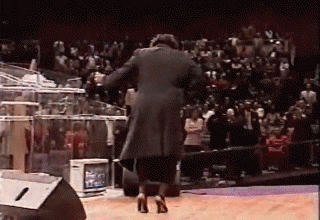
The grads recessed out of Woolsey and immediately searched for their parties and took pictures. Yaa was in the middle of her search when she felt two sturdy taps on her shoulder. It was him. “Hey, Doc.”, he greeted. Yaa scoffed as her billion dollar smile grew from a smirk. She playfully rolled her eyes and shook her head before reaching up for a kiss. “Hey, Duke. A girl can get used to hearing ‘Doc’. ”, she hummed into his lips. He finally broke the kiss and handed her a bouquet of her favorite roses: white, yellow, and pink. She gasped at the sight. “Baby! They’re beautiful.”, she squealed. She jumped right back into his embrace. “More where that came from, Denae.”, he whispered.
He never called her Denae, nor did his voice ever get that deep whenever he talked to her. She shot him a look before kissing him once more and walking towards the Migos, who were all Snapchatting and gassing her up.
“BEST FRIEND DONE GOT A WHOLE FOURTH DEGREE, Y’ALL!”, Daveon yelled. Yaa’s shoulders shook as she laughed at her foolish ass friends.
“Yaaaaaasssss ma’am! You better be Black Excellence. C’mon, Lil’ Angela!”, Kimya called.
“Bitch, I’m just tryna see the outfit. The people deserve to see what you’re wearing.”, Tanisha bluntly stated. The other two egged Yaa on to unzip the massive black gown. The only thing everyone could see were her black velvet smoking loafers. She unzipped the gown, unveiling a black pencil skirt and a white shirt with “PheD the Hell Up” written in blue. She would always get the laugh in somewhere.
She insisted that the family take pictures at her rental house because it was still December in New Haven, Connecticut. Chatter, laughter, and faint sounds of Black Christmas music filled the house as both families meshed as one. Carrie and Momma Cora held conversation most of the afternoon; Cindy and Khadijah exchanged medical stories; and Mustapha and Rainey discussed everything under the sun with Avery, Jahlil, and Winston. All four of the Migos were upstairs taking naps to prepare for dinner. Yaa especially deserved that nap. She hadn’t a decent amount of sleep since returning from Thanksgiving in Louisiana.
“Where’s Khalida? I think it’s time we all split.”, Khadijah asked Winston.
“She’s up there with her friends taking a nap. Gal deserves it. That means we need to leave and take naps of our own before dinner tonight.”, Carrie replied. “Winston, you staying here or something?”
“Yes ma’am. I might as well join the Snooze Crew upstairs.”, he said walking towards the front door. He finally went upstairs to Yaa’s room where he was greeted to a room full of snoring. Yaa’s petite figure was curled up in the middle of the messy bed. Her locs were scattered across her silk pillows and her Breakfast at Tiffany‘s eye mask covered her eyes. Her mouth was open as she snored loudly.She was dead to the world. Winston chuckled to himself as he watched his beautiful scholar catch up on Z’s. He sat on the unoccupied side of the bed and watched her sleep. He cleared her face of her wild locs and stopped when she stirred. Eventually, she unmasked herself and gasped when she saw Winston.
“Shit! Don’t scare me like th... was I snoring? Oh fuck, how long have you been watching me?”, she asked. He shook his head before kissing her forehead.
“Yes, you were snoring. Don’t worry about that. I still love you. I’ve been here long enough.”, Winston admitted.
“Well, since you love me so much, let’s try to find brunch. I’ll wake up the crew.”, she announced as she crawled out of bed, “That way, we won’t be as hungry going to this bougie ass Mediterranean spot my folks selected for tonight’s dinner.”
He rolled his eyes, “You better be glad you graduated today, Pumpkin.”
-------------------
Olea Restaurant, New Haven, Connecticut, 8:15 p.m.
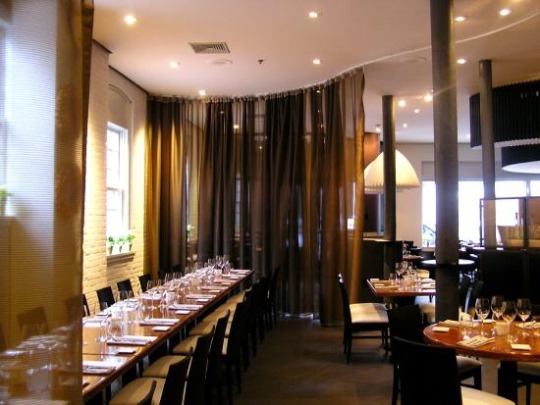
The graduation dinner was running smoothly. The private dining area was tastefully accented with gifts and Yaa’s graduation pictures. Nearly twenty minutes after the family arrived, Yaa and Tanisha walked in side by side. Everyone stood and applauded the woman of the hour. Winston stared in awe at Yaa who, as always, strutted into the room with such grace and power.
Khalida chose the more adult outfit option for dinner. She wore her locs in a low bun and kept her glasses, tam, hood, stoles, and medal on. Her royal blue dress fit snug. Though Khalida often wore form-fitting dresses, none were as form-fitting as this one. Her rather well-endowed chest and wide hips were brought to the forefront; her fupa was somewhat concealed by the side peplum panels. The nude pumps she wore were accented by her anklets. Truly a work of art.
“My goodness, sweetheart. This dress is absolutely divine on you.”, Khadijah commented as she examined her first born’s outfit.
“Ibby, you look refreshed. That nap did you some good,I see ”, Mustapha teased.
“Thanks, Umi and Baba.”, Yaa said. “Thank all of y’all for coming and supporting the kid. I can’t believe this is all happening. I’m like...finished! Yale really gave me a doctorate.” The realization of her journey’s culmination brought tears of joy to the “hard-nosed” Yaa. She finally sat the far end of the table next to Winston.
“Pumpkin, you look divine.”, Winston whispered in Yaa’s ear during their hug and kiss. He twirled her around to get a better look of her outfit. She’s going to be the death of me.
“Why, thank you. Gotta show school spirit, y’know.”, Yaa joked. Winston pushed his girlfriend’s chair up to the table.
“I’d like to make a toast...”, Winston stood and began, “...to the woman of the hour, Doctor Abdullah. I know we’ve been in each other’s lives for not even two months, but watching you work and grind towards your goals has given me the initiative to better myself not only as an up and coming actor, but as a person. Khalida, you give me more reasons to be the luckiest man alive and today is the pinnacle. I love you so so much, Khalida, you have no idea. So here’s to our Khalida and her many successes now and forever. Ase.”
The table echoed scattered “Asé’s” and “aww’s” as they clinked their glasses. Yaa cheesed to keep tears forming as she looked into Winston’s eyes as he sat down. “I love you more,Winston.”, she declared as she kissed him. He placed his hand at the hem of her dress and rubbed her thigh. She cut her eyes to his hands and then directly to him; he replied with a smirk. Buzz buzz. Yaa wasn’t the only one who peeped Winston’s unusual behavior.

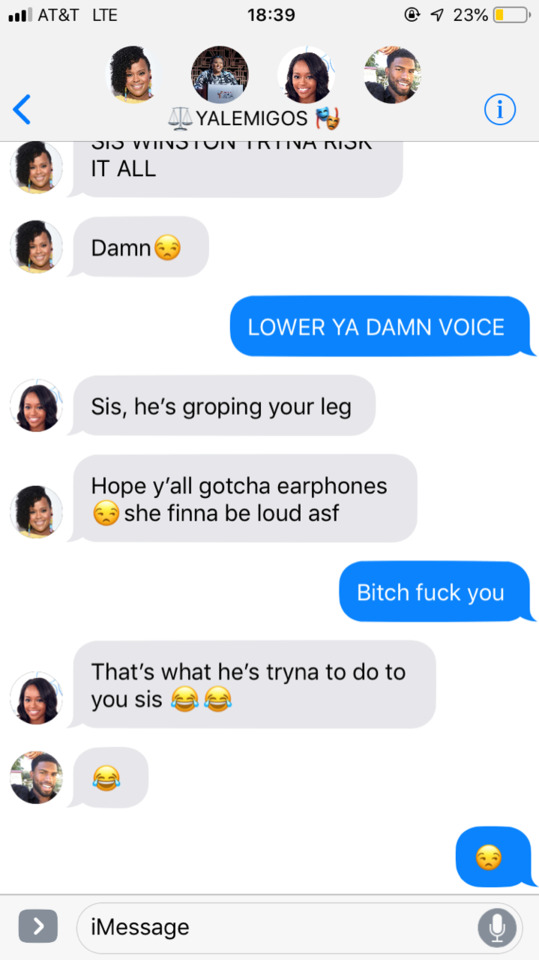
———————
Winston walked into the bathroom to see Yaa freedom her locs from its bun. He enjoyed seeing her hair down. She noticed him in the mirror studying her.
“May I help you,sir?”, Yaa questioned. Winston walked behind her and nuzzled her neck.
"I love you." he said, wrapping his arms around her.
"What has gotten into you, today? You haven't kept your hands off me all day." she said, giggling.
"I just want to show you that I love you. I think I may have just realized how much I want you." he said. She looked at him, taken aback.
"Want me? You are just now figuring that out?" ,she said, pulling away from him and crossing her arms over her chest.
"That's not what I mean." he said, in a low gruff voice. Yaa jumped slightly as she felt his hands grip her ample waist and pull her into him. As if it were instinct, she wrapped her arms around his neck. "Seeing you in that dress...having you this close to me."
She closed the last bit of space between her, biting her lip as he craned in. "You are the most gorgeous woman I've ever seen. You're smart, accomplished, hilarious. You are phenomenal. But there is a part of each other we haven't experienced.” He picked her up and sat her on the vanity. “And if it's okay with you, Denae, I'm tired of waiting."
She began unbuttoning his shirt. “I thought you’d never ask, baby.”, she whispered. Their lips met and the intoxicating kiss consumed them. Like a drug, their favorite drug. The slow tongue war continued as Yaa finally took Winston’s shirt off. Nothing was breaking this kiss. His hand traveled up her leg.
“Move your arm, baby.”, Yaa said between kisses. He looked at her with hooded eyes and chuckled deeply.
“That’s not my arm,love.”, he replied sensually. She stopped, mouth agape. She cut her eyes between his erect third arm resting against her inner thigh and the cocky smile and lip bite plastered on his face. This nigga finna split me open.
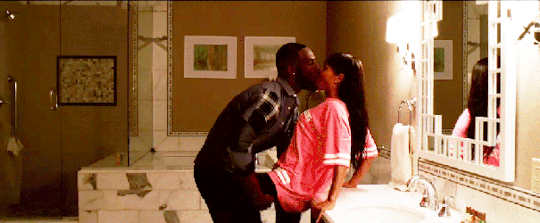
His hand continued its journey to her inner thighs, where he got down to nibble and kiss them with such intent and passion. He picked her up and traveled to the bed. While on the journey, Yaa bumped her head in the doorway of the bathroom. She giggled as he placed her gently on the bed. “Oh my God, Pumpkin, are you okay?! Do you need ice? Please say something.”, Winston rambled nervously. He swiftly placed her on the bed and turned on the lights to examine her head. She finally opened her mouth and laughed...hard. It could’ve been from the bump or just the fact that she was a bona fide clown. Her laugh turned into an all out cackle, prompting Winston to laugh with her.
“I’m fine, love.”, she began saying in between cackles and breaths, “I just bumped my head.If I pass out, just take me to the hospital. No questions.” The passive tone she used made it difficult for Winston to decide if she was joking or being dead serious. Either way, he appreciated how she broke the thick tension between them. The perfect icebreaker. They finally got themselves together and turned off the lights.
“I hate for such a nice dress to come off, but I wanna see what masterpiece is underneath.”, he commented. Lord, that voice. He lifted the dress over her head, where he was met with her ample cleavage being confined by a red lace bra. She freed herself of her bra and he began caressing her breasts.
“I’ve been trying to get to these since we met.”, he commented. She laughed.
“I know. You looked at them like they were water in the desert.”, she answered laughing. As if on cue, he took one in his mouth, swirling his tongue around her nipple and sucking on it. His tongue traveled up to her sweet spot on her neck. Chills. Her sweet moans served as motivation for his assault of her neck.
Satisfied, he came down and began slowly peppering wet kisses on her feet and leveling up to the inside of her thighs. Shit, spot #2. He looked up to see his girlfriend’s face consumed with pleasure. She bit her lip as she looked down at him with hooded eyes. She cursed under her breath with every kiss he placed. Finally, he kissed her opening, eliciting a back arch and a drawn out “Shiiit!” from Yaa. His mouth became friends with her opening as he sucked on her bud and his tongue explore. He added two fingers as he latched onto her clit. He began pumping his fingers inside of her with a moderate pace. He alternated his sucking with kissing and licking,prompting more hushed cursing from his lover. She was unraveling. He stopped but kept his fingers inside of her. “Fuck you for teasing me like this.”, she moaned. He chuckled. She’s a mess.
“I want you around me, Denae.”, he commented as his fingers brushed up against her opening and examining her nectar. He slid his body between her legs and slid his member inside of her. Her head flew back as his girthy member went deeper inside her tight opening. He noticed her twitch as he lowered himself into her.
“Are you ok,Denae?”, he said examining her face.
“I’m not used to you yet. I’m just tight. I’ll be fine.”, she reassured. Carrie and Khalida ain’t raise no bitch. They both moaned as they began grinding in sync.
“Shit, you fit around me like a glove.”, he moaned, his voice saturated with lust. She kissed him in response.
Winston peppered wet,sloppy kisses on her neck as he rolled his hips, hitting her g-spot deep with every stroke. His pace was slow but unyielding. Her sweet moans and gasps mingled with his low grunts and occasional higher moans. The room was clouded in lust. Besides the sounds of wet skin slapping, moans, and pants, Maxwell’s “Whenever Wherever Whatever” played softly in the background.
Now straddling his lap, Yaa found herself holding back tears as her sexual appetite was being satisfied to her liking. She balanced herself with one hand rested on Winston’s bare chest and the other on the bed. She bounced on his dick as he held on tightly to her love handles. He watched with hooded lust-filled eyes as his girlfriend’s breasts bounced freely against her pace. Her bounce slowly devolved to a twerk and then a gyration as she neared her peak. She was sending him into a tizzy as she clenched tightly onto his dick. If they weren’t already in love, this moment would be when they’d fall in love. Their moans echoed in response as feedback for the other. They were both coming undone. Their rhythm became disonant as they neared the end. Winston sat up and sloppily kissed his girlfriend’s neck. Her breath hitched as they stared into each other’s eyes, both pairs stinging with tears.
“Winston,baby, you feel so good.”, Khalida uttered between her teeth and tears. Her tears and desperate moans served as Winston’s motivation to cum.
“Cum for me, baby.”, he whispered into her ear. He released a low growl; that did it for the both of them. She roared into his shoulder as the sensation of their simultaneous release overwhelmed her core. She collapsed from the sensation.
————————
Yaa and Winston found themselves physically exhausted from their lovemaking. They laid in bed in silence, reflecting on what just occurred. She laid her head on his chest as he tried detangling her locs with his fingers. He gently kissed her locs. “That was...wow. That was uh.”, Winston attempted to strike up conversation.
“Intense? I think that’s the word you’re looking for: intense.”, Yaa suggested. She looked into his eyes and kissed him.
“Yeah, intense. Literally the word I was looking for. My mind is going 25 miles a second. I can’t believe we finally did it.”
“Yours too?! This is...wild.”
“How?”
“Everything we do together feels so organic. I’m really not one to openly be a sap, but you’re so right for me. Being around you makes sense and what we just did is a feeling I’ll never get over...ever.” She interlocked her small fingers into his larger ones and kissed his knuckles. He chuckled as his free trailed between the valley of her breasts.
“I guess your cousin Daniel was right…”, Winston said lifting her chin up to meet his eyes.
“The fuck is he right about?”, she shot up staring him dead in the face. He kissed her lips.
“...I guess I am responsible for making a hard G soft.”, he flinched in anticipation of whatever assault was coming as consequence of his statement. One tickle and pillow fight later, the two found themselves out of breath once more.
“You know, Chris, to be a health nut, you in worse shape than me.”, she giggled.
“Oh, shut up and go to bed.”
OH THIS THE TAG LIST TAG LIST!
@muse-of-mbaku @kumkaniudaku @eriknutinthispoosy @whoramilaje @mbakusthrone @mbakuwife @great-neckpectations @inlovewithmakeupcomicsanimelove @jackburtonsays @randomwordprompts @bartierbakarimobisson @wakandan-flowerz @blackpantherreblogs @babygirlofwakanda @eerythingisshaka @washyourlinens @wakandas-vibranium @dramaqueenamby @destinio1 @sonofnjobu @teheeboo @sarahboseman @iamrheaspeaks @texasbama @chaneajoyyy @lovelynervouschaos @cay-cah @coonflix @katasstrophey @mareethequeen @jozigrrl @jellybean531 @yofavcocoa @storibambino @maya-leche @blackgirloneshots @royallyprincesslilly @niquelafleur @certifiednatural @supersizemeplz
55 notes
·
View notes
Text
International Day of Women and Girls in Science - 2019
The Royal Alberta Museum is fortunate to have many amazing women doing scientific work on our staff. As February 11 is International Day of Women and Girls in Science, we are highlighting a few members of our conservation team, who utilize scientific methods of preserving and conserving our precious objects.
We’d love for you to meet Carmen, Katherine, Genevieve and Brenna!

(Conservation team - Top: Katherine Potapova. Middle L to R: Lisa May, Carmen Li. Front L to R: Brenna Cook, Alison Fleming and Genevieve Kulis)
What do you do here at RAM?
Carmen Li
I am head of the conservation program here at RAM. The goal of the conservation program is to ensure the long term preservation of the specimens and artifacts in our collection through treatment or preventive conservation.
Katherine Potapova
I'm a paper conservator. For the most part, I repair damaged documents, maps, photographs, and other artifacts that are made of paper. Sometimes, I also help out with other conservation-related task, like preparing objects for exhibition in the galleries, and operating the equipment that we use to run tests to better understand what our artifacts are made of.
Genevieve Kulis
I am a Natural History Conservator here at the RAM. I am one of the people responsible for ensuring the ongoing care and preservation of museum’s Natural History collections. As part of this work, I get to carry out various treatments that help to repair and stabilize damaged or deteriorating specimens and objects.
Brenna Cook
I am a textile conservator. I work with textile-based objects to treat and preserve them while also preparing them for display.
What first made you interested in conservation as a career?
Carmen Li
I first heard about conservation as a career at a high school career fair, but never thought I could pursue it because of the chemistry requirements. I began studying architecture and art history, but really started reconsidering during the third year of university. I decided to follow my passion and started intensively taking first, second and third year chemistry courses in preparation for a graduate degree in art conservation. Conservation allows me to exercise both the artistic and creative side of my brain as well as the materials science part. It allows me to engage in meaningful work, and since every project is different and since we work on such a diverse collection, conservation work really is endlessly fascinating and a source for lifelong learning.
Katherine Potapova
I've always had diverse interests, and had a hard time deciding on the one thing that I wanted to pursue. In university, I was torn between fine art, history, and science. When I found out about conservation, it seemed like the perfect solution: conservators need to have skills and knowledge from all these areas. Conservators need to think systematically, like scientists. Conservators also need to understand the materials they work with on a molecular level. At the same time, they also need the creativity and craftsmanship of artists, as well as an understanding of the history of materials.
Genevieve Kulis
I have always loved museums and have found them wonderful places to learn and discover new things. Growing up, I always felt that working at a museum would be a dream come true, but didn’t know in what capacity I wanted to do that. After some research into various museum careers, I came across conservation. It had a great balance of all of the things I was interested in. It allows you to use both science and art-based skills, there is a great deal of diversity in the projects you get to work on, and it allows you to work with incredible objects and help preserve them for other people to enjoy and learn from. To me, nothing seemed to match my interests better than that.
Brenna Cook
I always had an affinity for working with textiles and a strong interest in history and material culture. I enjoyed the combination of craft and science as well as the deliberate, measured pace of work.
What was your education and career path that lead you to your current job?
Carmen Li
I pursued a bachelor’s degree in Architectural Studies and Art History, followed by a certificate in Collections Conservation and Management and then a Masters in Art Conservation. I completed internships and fellowships at the Canadian Conservation Institute, the National Museum of the American Indian, Fitzwilliam Museum, Royal Ontario Museum, and others. I coordinated a major collections move at the Museum of Northern Arizona, and then was hired as the Preventive Conservation Manager at the University of Alberta Museums which brought me to Edmonton. I joined the RAM team in 2014.
Katherine Potapova
I was halfway through a bachelor's degree in art history when I decided to try my hand at conservation. After receiving my art history degree, I went on to pursue a Master of Art Conservation degree at Queen's University. To meet the admission criteria for the conservation program, I also had to take general and organic chemistry courses, and also fine art courses, while I was finishing my art history degree.
All the conservation programs in North America are postgraduate, meaning that you need to have a degree in some other discipline to be eligible. People come to conservation from a great variety of backgrounds: fine art, history, and chemistry are some of the more common ones. Conservation is such a crossroads that skills from many different disciplines can be applicable. Everyone who wants to be successful in conservation also needs to have some knowledge outside their own discipline: a scientist needs to have some experience with art or crafts, and someone from a humanities background needs to have at least a basic knowledge of chemistry. And of course, everyone needs to be comfortable working with their hands.
Genevieve Kulis
I first attended McGill University, where I majored in Anthropology and minored in Earth and Planetary Sciences. I was fortunate enough to have a number of my classes at the University’s Redpath Museum. Having classes at the Museum allowed me to work with the collections for various lab sessions and research projects, and really solidified my interest in working at a museum. I also began volunteering there, when I could. After I graduated, I attend Fleming College for their post-graduate program in Cultural Heritage Conservation and Management. The program was really immersive and hands-on, and included a full-time internship in the final semester, which I completed at the Textile Museum of Canada. After completing my internship there, I continued to volunteer and eventually was hired on a project contract. After my contract was over, I began working as a conservator for private collectors and short-term contracts. Soon after, I found my way to the Royal Alberta Museum, where I’ve been working for the past two and a half years.
Brenna Cook
I started my post-secondary education interested in archaeology but over the course of a bachelor’s degree in the subject I discovered it wasn’t a career I wanted to pursue. I rearranged my coursework and volunteer experience to support an application to a graduate degree program in textile conservation. Following that I completed several years of internships until I secured this position at the RAM.
Tell me about some of the ways you use science in your work.
Carmen Li
The most obvious way that I use science at work is through analysis of objects or specimens. For example, we can do X-Ray Fluorescence to identify what elements are present in or on the surface objects, or we can do Fourier Transform Infrared spectroscopy to try to determine what an object is made of. But more generally, through an understanding of materials science, we can try predict how materials will degrade over time, how our conservation treatments would interact with original materials, and they would age over time.
Katherine Potapova
Science is really just a systematic way of figuring out what things are made of and how they work. This kind of systematic understanding is at the heart of many fields, including conservation. When working with museum artifacts, it can be very important to understand what each artifact is made of, and how these materials will behave over time. For example, some materials, like some papers and many plastics, are inherently unstable: over time, these materials often turn yellow and become very brittle. Sometimes they become so brittle that they crumble if you so much as touch them. To preserve these materials in the best conditions possible, special accommodations are needed. We wouldn’t know this without a scientific understanding of the artifacts.
When I do conservation treatments on damaged artifacts, it is also important to understand on a molecular level how the materials that I use will interact with the materials of the artifact, and how they will change over time. For example, many people who are not conservators might use sticky tape to repair tears in documents and book pages. What these people don't realize is that over time, the adhesive in most tapes undergoes a chemical reaction that causes it to turn yellow. This can happen in just a few years, although sometimes it takes 20 or 30 years. The yellowed adhesive creates an indelible yellow stain in the paper. When conservators repair tears in paper documents, they do not use tape, but rather adhesives like wheat starch paste, which have been thoroughly tested by scientists to make sure that they remain stable over time.
I have also had the opportunity to use some fairly sophisticated instruments to run tests that help to better understand the behaviour of the materials in our artifacts. For example, it is well known that many coloured materials fade when they are exposed to light for an extended time. But different materials fade at different rates. How can we know for how long we can keep a particular artifact in the light before it starts to fade? To help answer this question, we borrowed a microfade tester from the Canadian Conservation Institute. This instrument shines a narrow beam of very bright light on a very small, barely visible spot on an artifact for a specified length of time (for example, for 10 minutes). The instrument also takes repeated measurements of the colour of the spot. The computer software uses these measurements to calculate how much the spot has faded. These data can then be used to extrapolate how quickly that particular colourant would fade under regular museum lighting. I got the chance to use the microfade tester on some of our most light-sensitive artifacts, and we used the results to decide for how long these artifacts could safely be displayed in our galleries.
Genevieve Kulis
Science finds its way into my work in a number of ways. It’s a fundamental part of understanding how and why an object may be deteriorating. Understanding and identifying the types of chemical reactions that are taking place within the object itself, or between the object and something from the surrounding environment, that are causing deterioration is very important. This information informs a conservator on how to best proceed with treating the object. Science is also used during the treatment and preservation of the objects. It is important to know how an object will react with the materials being used in a treatment. Some materials or substances can be used to slow or stop types of deterioration, which can be very useful. In other instances, even just knowing what materials are safe to use with or around an object that won’t cause any adverse reactions is extremely important. Having a solid understanding of material science is quite essential.
Brenna Cook
We use scientific instruments broadly in conservation to discover information about the physical nature of materials. Most applicable to my work is our Fourier-transform infrared spectrometer (FTIR) which can tell me the chemical makeup of mystery textile fibers. I also use very precise lab equipment when custom dyeing fabric as minute changes in dye stuffs, water and additives can have a great effect on the resulting colours of the fabric.
What is the coolest thing you have had the opportunity to do in your career?
Carmen Li
I’ve had the opportunity to travel and work on projects in museums and archaeological sites around the world - Canadian Arctic, Turkey, Peru, Hong Kong, UK, the Netherlands, Kosovo. All these experiences enrich my understanding of conservation of different material types, from different cultures, and in different contexts. In terms of the single coolest thing, I’ve had the opportunity to help with the installation of the Durham Cathedral’s copy of the Magna Carta when it came here to Edmonton, which was pretty special.
Katherine Potapova
Working with museum artifacts can feel pretty special. I don't really know what the "coolest" thing that I've had to do would be, but my favourite thing that I get to do is inpainting. When a photograph, poster, or some other kind of picture has scratches or cracks in it, the damage often prevents you from seeing the image properly. In that case, I sometimes paint over the scratches with watercolour paints. I do this with an extremely fine paintbrush, and I have to mix colours so that they match the colours of the area around the scratch very closely. If I'd done a good job, you would then no longer notice the scratches, unless you looked very closely. When my inpainting turns out well, I always feel like I have a kind of magical power. Suddenly the image comes together, and you see it clearly for the first time. It always amazes me what a tiny amount of well-chosen paint can do.
Genevieve Kulis
I don’t think there is a single coolest thing I’ve had the opportunity to do as a conservator. All the objects I get to work on are unique and have their own interesting set of preservation challenges. There is so much diversity in what I get to do as a conservator; I’m never bored and always excited about what I’m working on.
Brenna Cook
I’ve had the chance to get right up close to clothes that people wore hundreds of years ago, I was particularly excited to work on some French dresses from the mid-eighteenth century. You can’t get more intimate with the people of the past than that!
What is your advice to young girls interested in pursuing a career in science-related careers like conservation?
Carmen Li
Courses in science and math can lead to so many interesting and diverse career paths. Anyone can learn anything with curiosity, drive, and passion. Be fearless and follow your dreams!
Katherine Potapova
Do what interests you! Scientific thinking has applications in just about every field, not to mention everyday life. If more people had a science-based education - who knows, there might even be less nonsense in the world.
Genevieve Kulis
If you find something you’re passionate about and interested in, pursue it. Find ways to learn more about what interests you, whether that be through independent research, reaching out to someone already in the field or finding a way to volunteer in some capacity. In particular, I would say volunteering is an amazing way to get practical, hands-on experience and is a good way to find out if your area of interest is something you want to get into as a career. Even if you aren’t able to find someone in your field of interest to get in touch with, or volunteer with, immediately, don’t let that discourage you. Perseverance does pay off, so do your best to keep at it and eventually, an opportunity will come up that will allow you to get your foot through the door.
Brenna Cook
I would advise young girls to indulge their curiosity. Information is becoming more and more accessible and really digging down into a question is what science is all about!
5 notes
·
View notes
Text
What is a good co-ed/girls school in North India offering humanities?

The best co-ed schools in North India are the ones that have a good mix of curriculum and sports.
Also, boarding schools offer a unique experience from regular day schools as it allows students to grow at their own pace under the guidance of teachers/guides 24×7, unlike most public or private schools that close during vacations. The best girls' school should allow students to explore and learn different aspects of life and experiences.
As per research conducted by schools in Mumbai So you're a foreign student, or even an Indian, who's reading this post and about to venture into the scary, unknown world of finding a college in North India amongst the 2,000 other students applying for the same colleges.
Another survey done by schools in Bangalore if you're from a top-class school abroad or have a high percentile in your previous board exams, then finding such an institution for yourself would be much easier. However, if you are neither of these two types of students (like me), then I'm here to help you out find a good college within your budget.
It is said that the youth of today face a lot of struggles be it something we call identity crisis, peer pressure or finding their self-value. Whatever the reason might be, a majority of young people want to find solutions to these problems. And North India is a good place to look for it.
The best school in North India is Delhi Public School, R K Puram, New Delhi. It is a co-education school and offers the best education.
The admission criterion of the school is different for each class and depends upon the age of the child, who seeks admission.
If you are looking for a good school, which offers humanities and is situated in North India then this school will be the best option.
You can get all the information regarding admission criteria and other details on the official website of DPS RK Puram and can also apply online for admissions.
But if you are looking for a better option than this then I will suggest you go for a residential school which provides world-class education with state-of-the-art facilities, like for example:
The best colleges in India are:
- St. Stephen's College
- St. Xavier's College
- Christ University
- Loyola College, Chennai
- Miranda House, Delhi
- Presidency College, Chennai
- Sri Ram College of Commerce, Delhi
In Indian schools, humanities (also known as social sciences) is one of the popular subjects among students. The subject includes history, geography, political science, and economics. These subjects are offered as a group to students throughout their school life.
The subjects that fall under the stream of humanities are generally studied by students who want to pursue a career in areas such as public service, administration, law, and teaching. However, many students do not receive proper guidance about this stream of studies.
Let’s look at what’s on offer for students who study humanities:
Studying humanities will help you develop your reading and writing skills which are essential for most careers. Students studying humanities also tend to have a broad and deep knowledge about the world around them as well as have good analytical skills which are valued by employers in most industries.
The subject is extremely beneficial for those who want to go into public service and education-related fields. This is because it develops your communication and presentation skills which are highly desirable in these fields.
It will also broaden your general understanding of the world around you which allows you to deal with situations with greater confidence.
If you are inclined toward these subjects then you should consider doing an undergraduate degree focused on humanities.
As a subject, humanities is about studying the human condition and is commonly defined as an area that includes the study of history, literature, music, religion, and philosophy. Humanities courses are usually offered at the undergraduate level in many colleges all over India.
Eligibility:
10+2 or equivalent examination with a minimum of 50% marks in aggregate from any recognized Board.
Some institutes may specify subjects as well. For example, Amity University requires that students have English as a subject in their 10+2 exam.
A degree in humanities is a gateway to a wide range of careers from education to business. Humanity graduates can also continue their academic careers by pursuing masters and doctorate degrees.
Humanities is the study of human culture, which includes various branches like art, history, philosophy, religion, anthropology, and language. Students who are interested in these fields can choose humanities as their major subject.
Apart from this, it also provides an interdisciplinary platform to the students who want to establish a career in multiple fields. Some of the other benefits of a humanities degree are:
The curriculum of a humanities course is designed in such a way that it helps you gain knowledge about different cultures, beliefs, and traditions. This can help you become more tolerant toward people who are different from you.
0 notes
Link
Every striver who ever slipped the rank of their birth to ascend to a higher order has shared the capacity to ingratiate themselves with their betters. What the truly exceptional ones have in common is the ability to connect not only with their superiors but also with their peers and inferiors. And only the rarest talents among them can bond authentically—not just transactionally—with the people who will help them be who they want to be in the world. It’s a preternatural, almost Promethean gift if you have it, and Amy Chua does.
Thus begins the scandal dubbed “dinner-party-gate,” the latest in the annals of Amy Chua, Yale Law’s very own Tiger Mom, whose infamous defense of Supreme Court Justice Brett Kavanaugh was the “dinner-party-gate” of its day approximately three years ago. Then, as now, Chua’s differences with some denizens of her milieu played out in the press, vituperations, allegations, insinuations, and all.
…
The reporting left open a pair of related questions: What, exactly, had happened? And, perhaps more salient, if what took place really was something on the order of a minor violation of an ad hoc agreement between Chua and the Yale Law School dean, Heather Gerken, why had the news spilled into the nation’s most prominent news outlets rather than fading below the fold of a campus daily?
It appears to me that what transpired amounts to a skirmish between a notorious professor and an administration that seemed so eager to relieve itself of her presence that it lunged at an opportunity to weaken her position at the expense of two students who were left to deal with the consequences of the ultimately aborted campaign. Still, the answer to the latter question is more revealing than any single aspect of the whole affair. It has to do with the culture of elite institutions, where putatively righteous ends justify an array of troubling means, and noble public virtues like fairness and safety cloak more prosaic motives—the kind of vulgar envy and resentment that people with the best manners deny.
Everyone is just trying to get ahead, after all; this is no less true, and perhaps even more true, at a place like Yale Law School. It just comes more naturally to some than others. In that case one must take matters into one’s own hands.
The proximate drama begins with a trio of second-year law students, friends and acquaintances for a time. There was a person I’ll call the Guest—all three students asked not to be named, and, believing young people should have a chance at carrying on after having their reputation destroyed or destroying the reputation of others, I agreed—who was born and raised in California. He’d arrived at Yale Law School optimistic and younger than most, having come directly from UCLA. During his first semester, he’d befriended the Visitor, a young woman from a suburb of Atlanta, Georgia, who had arrived on campus from Emory. The two made a happy pair: the Guest dreamier and prone to touches of poetry, occasionally drawn to Byzantine history and Christian theology; the Visitor shrewd, practical, and levelheaded, with a keen focus on the concrete facts of policies, problems, current affairs. After working together on a major project that fall, they became and remained close.
And then there was the Archivist, a young man whom the Guest had also befriended early in his time at Yale. The two young men bonded after meeting in their contracts class, after which they would find one another at bars and parties to chat about history, politics, and other shared interests. They met up in New York City for a trip to the Metropolitan Museum of Art; the Guest eventually gave the Archivist a key to his apartment, where the latter would often stop by to visit or do his laundry. In the second semester of their second year, things seemed placid.
And they may have remained that way, had it not been for a minor snag in the Guest’s academic year that put him on a path that would eventually lead him to Amy Chua’s doorstep.
…
Not that the Guest had any reason to contemplate any of this when, early in the spring semester of 2021, he decided to step down as an executive editor at the Yale Law Journal. The Guest, who describes himself as half-Korean, had misgivings about the way the journal’s staff had responded to his questions about the lack of racial diversity in its ranks, and his suggestions for addressing it. Still, even after making his decision, the Guest felt uncertain and unsettled. He confided this to the Visitor, who as a Black student at Yale Law had wrestled with similar questions, and she took it upon herself to bring them up with Chua during a Zoom meeting that served in place of the professor’s usual office hours. At that point, the Visitor recalls, Chua casually offered to talk with the two of them about the Journal affair at her home in New Haven, and the Visitor called the Guest to pass the invitation along.
Unfortunately for the Guest, the Archivist happened to be doing his laundry at his friend’s apartment when the call came, and he overheard the conversation, later documenting it as follows:
Feb. 18. I go over to [the Guest’s] to do my laundry. While at his apartment, I hear him call [the Visitor], who explains to him that Chua has just invited them over for dinner tomorrow. They discuss what to wear and what they should bring (ultimately deciding to bring a bottle of wine). [The Guest] makes zero mention of going over because of any personal crisis. After the phone call, he says that he’s been invited to a dinner party at Chua’s. [The Guest] implores me not to tell anybody so that Chua doesn’t get in trouble.
Despite his gumshoe efforts, the Archivist seemed to come away with a vastly different impression of the meeting than Chua, the Guest, or the Visitor.
…
By March, the Journal imbroglio was boiling over into the public sphere. Several of the school’s affinity groups had released statements, and the Journal had released information about the racial makeup of its editors—then the conflict came to the attention of conservative media outlets. Once more, the Guest had a series of questions for someone familiar with bad press.
…
When i was a little girl growing up in suburban North Texas not so very long ago, my grandmother, a housewife of the ’60s, would turn my cousins and me outside to play in the summer so she could sit at her kitchen table and chain-smoke her way through her library of paperback bodice-rippers. And when one of us would inevitably bolt back inside to complain about being annihilated with a Super Soaker at close range or nailed with a Nerf dart to the eye, she would always eject us with the same dismissal: Don’t be a tattletale. As far as childhood admonishments go, it was an interesting one—she wasn’t telling us not to do something, but rather not to be something.
I don’t credit homespun wisdom with any special salience. But the suggestion that it may be useful to morally evaluate oneself before volunteering to monitor everyone else’s conduct isn’t a ridiculous one. It’s wise to be careful that, in one’s zeal for justice or fairness or the more prosaic things that ride beneath those banners, one doesn’t lose sight of one’s own moral obligations or aspirations. And it’s decent, if you have a problem with someone, to take it up with them before running it up the nearest flagpole. But this is something people with the right views and the best degrees, it seems, simply do not do; just as the distinction between tattling and whistleblowing—resting, as it does, on a sober evaluation of one’s own motives and the stakes at hand—is one they often fail to make.
…
Up to that point, the Archivist had managed to gather only the flimsiest written evidence that the Guest and the Visitor had been to Chua’s home. Eventually, he composed a roughly 20-page PDF narrating the timeline of his private campaign to turn proof of his friends’ wrongdoing over to the administration—complete with screenshots of text messages, summaries of conversations, a reference to a secretly recorded phone call, and some offhanded musings on his peers’ moral laxity. The document would achieve campus infamy as “the dossier.”
…
Yale did provide the Guest and the Visitor with information on how to file a complaint against the Archivist and also took additional steps to protect them, including trying to prevent their names from circulating online. But neither the Guest nor the Visitor ever filed any kind of complaint against Chua, who, they still maintain, did nothing worth complaining about. And yet both of them have suffered—not in the jaws of the tigress herself, but in the subtler and more brutal back channels of the Ivy League, where every regal edifice hides a charnel house of human spirits. In the end, they were collateral forfeited in a cold war that began long before they arrived on campus, and that will continue long after it has spit out their bones.
0 notes
Text
Get Schooled on the TGNC Experience
The boy’s and girl’s bathrooms. The gym locker rooms. The battle of the sexes dodgeball game. The health class conversations. The binary sports teams. Lack of gender inclusive housing policies. The incorrect pronouns that get used despite attempts to correct people. Each day in a secondary school, and well into higher education, transgender and gender non-conforming (TGNC) students are told again and again that the space was never made for their success. The results can be devastating – lack of access to safe and encouraging educational environments, long-term damage to one’s mental health, compounding trauma responses, and an overall sense of invalidation, all of which may eventually lead to a TGNC never obtaining the educational goals they set out for themselves. As a young student in secondary school, I couldn’t fathom the idea of being anything other than a straight, cisgender person. Even as I went to college and started exploring my sexuality, it was clear that the university was not set up for TGNC students to succeed. Gender inclusive housing didn’t emerge until an experimental program was introduced my junior year, and only for non-first year students, cutting this inclusive program off for the students who may be in the most need given their lack of established community and friendships at the university. Single use bathrooms all over the university were segregated by gender, an issue that didn’t get much attention even when I advocated for change as the Housing Undersecretary in Student Government. I was in an environment where I saw being trans as a significant exception to the rule and very little was done to create affirming spaces outside of the campus’s LGBT Center. I was thankful to come to terms with my sexual orientation at this time, but it wasn’t until the end of my senior year that I felt brave enough to start exploring my nonbinary identity. So, I graduated and moved to North Carolina for graduate school. I started using they/them pronouns and identifying as nonbinary. Even with this newfound self-awareness, my age, having years of experience dealing with my mental health challenges, and my personal commitment to advocacy for the transgender community, I nearly didn’t obtain my graduate degree. Or survive, for that matter. Once again, single use bathrooms were split, there was a statewide ban against gender inclusive housing efforts, excuses for not trying harder to change structures were rampant and, on a personal level, my pronouns were disregarded by most people and I was told that I was seeking special treatment for wanting a bathroom that didn’t peel away parts of my identity and humanity. It took a mental health crisis to see any semblance of empathy or willingness to hear my suggestions for change. I was simultaneously heralded for my heroic and courageous existence and dismissed for my outlandish ideas for how to make campus more affirming. And so I think about trans youth in today’s world, where they have language, representation and, in some cases, affirmation that allows them to start exploring their gender early. I think about the fact that, while awareness has expanded, many structural barriers have not. I think about myself as a 22-year-old paraprofessional writing a 15-page proposal for a campus-wide change just so I could feel safe in the bathroom and then think about a 12-year-old kid who wants the same outcome but does not have the same tools to achieve it. These daily reminders that our schools weren’t made for us, even with murals and posters and campaigns that tell us we all belong painted in vibrant colors throughout the hallway, eat away at our ability to feel like our genders are real and that we have a right to exist in our most authentic forms. From an emotional and mental stamina place, before accounting for any financial barriers, accessing education that is affirming and welcoming to TGNC students is already a significant challenge that threatens their ability to persist through their educational journey. When it comes to financially affording college, 20-40% of the 1.6 million youth experiencing homelessness in our country are transgender, making affording university an often insurmountable challenge for those with unsupportive homes (National Center for Transgender Equality). When at school, TGNC Students, especially those at schools without a gender inclusive housing policy, often have to pay the huge additional cost for a single room. When you take into account the impact of emotional distress on someone’s academic success, you also have a disproportionate number of TGNC students who may not have the GPA for large merit-based scholarships. And given the lack of blanket guidance and policies for all institutions of higher education across the country, TGNC students may feel pressure to reach for a more expensive private liberal arts type school that has more affirming policies for them than an affordable state school that has done little to adapt their campus to support their success. TGNC individuals have to balance working a part-time job like most other students while spending extra hours in meetings with administrators to explain why they want a gender inclusive housing option, or why the campus needs more bathrooms, or why their professor not using their proper pronouns is harmful, or why they want their name changed in the system. This is above and beyond that fact that 1 in 4 transgender people will lose a job to gender discrimination (National Center for Transgender Equality), making work and employment an unstable experience for most transgender youth as it is. Being TGNC is not a predictor of one’s academic success, but secondary and post-secondary institutions alike make it exceedingly difficult for TGNC students to access the same safe, supportive, and affirming education as their cisgender counterparts. We deserve better – TGNC individuals bring a depth of perspective about the world that is missing, and we are ready to be the next leaders in our chosen fields. For me, that means fighting for schools to be better and do better for their TGNC students. Our time is now.
Seeking ways to get financial support for your education goals? Apply for the #TransgenderFirst scholarship: https://www.onlinedegree.com/transgender-first-scholarship/
0 notes
Text
Physiotherapist - A High Demand Career Option
Physiotherapy helps restore movement and function when someone is affected by injury, illness, or disability. Along with it, a physiotherapist helps people affected by injury, illneyear, the demand for Physiotherapists is continuously increasing.
The physiotherapy degree program is offered by top physiotherapy colleges in Bangalore, or elsewhere. Krupanidhi College of physiotherapy is one of the oldest and best in the nation. It was established in 1985; this college is a comprehensive and student-focused institute that works towards excellence in quality education. This college was the first institute which started Physiotherapy as a course in Bangalore.
The institute aims for academic excellence and the complete overall development of the students. They focus on not just theoretical knowledge but also provide practical experience to the students. A modern process of teaching, training, and evaluation is followed at Krupanidhi ss, or disability through movement and exercise, manual therapy, etc. This is one of the reasons why every according to the latest trends in technology and commerce.
The faculty here is highly experienced and ensures that every student gets the right knowledge and training for the industry.
Krupanidhi Campus
The college is situated in a peaceful atmosphere in Bangalore with an 11 acre Campus which contains a sense of calmness in the minds of the young, facilitating learning. From large spacious classrooms to a great and diverse library, Krupanidhi has covered all the needs of a student. For students who live away from home, they have separate hostels for boys and girls. A well-equipped gymnasium and fitness centre can also be found on this campus. The food court on the campus is multi-cuisine. This is the place where students come to relax and take some time off from the hectic college schedule.
The state of the art Fitness laboratory, electrophysiology lab, therapeutic gymnasium, and attached gait and movement science lab allows students to learn skills first hand and implement them with their patients.
Campus Placements
Krupanidhi has been crowned as one of the 'fastest-growing private educational centres in Asia', at the WCRC Leaders Asian Education Excellence Summit and Awards ceremony. They conduct campus interview in association organizations such a
IIT industries
Fitness centre
Orthopedic hospitals
Neuro specialty hospitals
Cardio specialty hospitals
Sports centres
NGO'S
Private clinics
The college has some of the most dedicated, knowledgeable and experienced members from the different specializations of physiotherapy. They not only teach and impart knowledge to the students but also mentors students with utmost patience for their overall professional as well as personal development.
0 notes
Text
Child Sexual Abuse, Consent, and What I believe
When I was little, a toddler in water-wings, my mother encouraged me to press my genitals against the pump jet of a swimming pool. She said to let it tickle my private parts.
I only had abstinence only education and didn’t know what masturbation meant for girls until I was 19 years old. I didn’t understand what my mother had taught and encouraged me to do, in public, as a toddler, until I was an adult. It horrified me, and I still don’t know how to feel about it.
My mother was abusive, but I didn’t think she was a child molester. The men she dated...not so much. She liked men that hurt her, she choose men that weren’t safe and she didn’t think about safety.
When I hit puberty things changed. I was outgrowing being her baby and she got back into heavy drug use. Since I couldn’t be her baby, she saw me all grown up. At 12.
She encouraged me to drink, to do drugs, to have sex. She set me up with her friend’s kids, other drug users who she sold too, who has sons around my age. She wanted me to do sex work, but didn’t want to force me. I think she thought if she could get me into sex and partying, I’d agree.
She guilt tripped me about it a lot. She abused and neglected me and put my life in danger (I almost died so many times) but would always insist she was a good mom, because she’d provided for me for all these years, and because she never sold me. Her friends, the ones with teenage daughters, they helped their moms earn money on the street, but she wasn’t making me do that. I should be grateful. She owed the cartel a lot of money, she could sell me, but she wasn’t. She said I was ungrateful when I refused to come home and started staying on a relative’s couch because I was afraid. If I really loved her, I’d die with her. After all, she’d never sold me. Never made me do what she’d done plenty of times.
Just the threat. And the reality that she left me alone with even more dangerous men and pushed me to do things I was too young to do.
It was fucked up. Sometimes it’s hard to wonder if I’m fucked up, but rationally I know the child isn’t responsible for the parent’s choices.
For my part, I survived by focusing on school. I’d pretend to have essays I needed to do so I could stay over at my relatives to use their computer (and do the extra work I made up, in case she checked). I got into praying the rosary, and became Christian. I vowed to be abstinent until marriage.
I kept my vow. On my wedding night, I discovered I couldn’t consummate the union until I had surgery to repair some internal damage. Even after I’d healed, I didn’t want sex. Last year I did a year of pelvic floor therapy and it helped. I’ve blogged about it, tagged recovery. I’m also doing DBT and other therapy.
I was sent to live with out of state relatives at 14, and I was on my own at 18. I went to college and earned a degree in Creative Writing, with a minor in pre-law. My pre-law minor was a blend of criminal justice and social justice, with a focus on crimes against women. I wrote research papers on the impact of porn on violence against women (none - as far as I could find). I wrote a research paper on sex trafficing. I wrote a research paper criticizing Twilight romanticizing abuse. I compared U.S. laws to international laws and thought about what policies protects minors from abuse.
I went on to law school. I loved Constitutional law and became Vice President of my school’s chapter of the ACLU. I agreed with the Comic Book Defense League on censorship cases. Stories don’t have to be perfect. You can and should criticize media for how it reenforces harmful norms in society, but not insist that some things shouldn’t be depicted. Questioning what’s being presented is inoculation against continuing to follow harmful norms without thought.
I’m deeply anti-censorship and pro-art. I’m deeply pro-criticism. I’m deeply anti-child abuse and exploitation. I’m in favor of looking at norms and policies and asking, is this helpful.
I never wanted to be sexual as a teenager. I wanted to be good and pure and have something about me that was valuable despite the fact I had nothing in the world. Abstinence Education taught me that.
But when I looked at classmates who had sex as young as 14 or dated college guys at 17, I didn’t like that I was judging them.
I didn’t agree with the idea that gay people were going to hell, or a girl was somehow dirty if she had sex. The more I studied feminism in college and moved toward pro-sex feminism and rejected rad feminism, the more I was exposed to actual sex education and unlearned shame, I couldn’t judge people.
If someone wanted to have sex at 14, it was their choice. Not necessarily a smart choice, but still their choice. What was bad was when they weren’t really given a choice. When they were forced into sex or pressured into sex, and taken advantage of by older partners or abused by people their own age.
The more I learned, the more it bothered me that we don’t really emphasize the importance of consent. Our culture doesn’t value educating people so they can recognize abuse and make informed choices. American age of consent laws don’t criminalize exploitation of young people, instead they treat them like their parent’s property to control - we haven’t outlawed child marriage.
I’ve represented children in CPS custody. In my state, the children get their own lawyer, and I argue what’s in their best interest to the Court. The cases drag on forever because the law requires doing everything possible to reunite parent and child. To give the parent every chance. Because the parent has a fundamental right to their child.
What other relationship do we have a mandate that the victim has to reconcile with the abuser?
My belief is that children are people, and they should have their own rights. The right to have their best interest come first and not be forced to be with parents who don’t take care of them. That when they’re old enough to make informed choices, they should be able to make choices. Including not being forced to drop out after 8th grade because of the parent’s religious belief, not being forced into marriage, not being punished for their sexuality or sent to institutes because of it. The right to consent to sex when they’re old give consent. The right not to be exploited, coerced or taken advantage of adults in power. (I really like Germany’s approach).
12 notes
·
View notes
Text
10 Benefits of Pursuing Law from Invertis
Pursuing law rewards you with success in life as it opens umpteen career options. However, you must acquire a degree from a top law institute in India because that aspect matters a lot. Invertis University, Bareilly is one of the best private law colleges in India. They help nurture students’ talent and help them reach their full potential.

Best law colleges in India like Invertis will open several doors for you, helping you embark on a successful journey. One of the oldest and most interesting professions is being a lawyer. Today, some study law to ensure justice while some do it for the courtroom drama. But, whatever your reasons are, take a look at why pursuing law from Invertis is beneficial for you.
1. Strong Foundation
Invertis University offers a chance for its students to combine legal studies with non-legal subjects such as business or accounting. This not only helps them strengthen their hold on law, but is also well-versed in other subjects.
2. Range Of Career Options
As a law graduate, you are not only eligible to become a lawyer but you can also work in the field of media, academia, social work, politics, and more. The university nurtures your talent and offers placements to ensure you have a job when you step out of the college.
3. An Award-Winning Institute
Studying at an award-winning institute means people recognize your university and a sense of respect is shown since getting into good institutes is never an easy chore. Right from winning Best Emerging University of North India to Best Innovative University, Invertis University is one of the top law colleges in India.
4. Infrastructure
Invertis offers the best infrastructure out there because the environment in which you study also matters. Located on the outskirts of the city, the students are offered peace and greenery. With a state-of-the-art facility, game rooms, and more, they offer you a complete package.
5. Mastering Critical Thinking
Invertis enrolls only the best teachers in the industry. Therefore, the teachers here help you master critical thinking, strong reasoning, and analytical skills.
6. Excellent Hostel Facilities
With three hostels dedicated to both girls and boys each, they also offer a big mess where all come together to share their meals amidst picturesque surroundings.
7. Medical Help
Students' well-being is of uttermost importance. Right from having first-aid care to ambulance facilities on campus, the college has a tie-up with Clara Swain Mission Hospital, where medical care is provided free of cost as it is covered under a medical insurance policy.
8. Development Of Self-Confidence
With personality development programs offered by the institute, you can develop your self-confidence, which is a crucial trait to become a lawyer.
9. Cafeteria
They also have two canteens present on the campus for students to enjoy good food while sitting inside an air-conditioned room and enjoying the scenic beauty outside.
10. A World-Class Auditorium
Invertis offers one of the best auditoriums in North India where eminent speakers and performers frequently take the stage for student’s entertainment. They ensure it resonates with your dream college.
0 notes
Text
The 13 Best Pinterest Boards for Learning About Things to do in Minneapolis
Minneapolis Minnesota
Outdoor attractions in Minnesota include Minnehaha Falls, a beautiful
environment-friendly space located in the heart of Minneapolis. The falls are among
the main Minnesota attractions when seeing the Double Cities. The
sprawling building affords visitors superb hill cycling tests,
hiking routes, outing areas and lots of other tasks.
Regarding Minneapolis
Revealed block, wood floorings, gas fireplace, 3 panel doors, all-natural
woodwork, fantastic kitchen granite counter tops and also stainless-steel
devices, in an open design with a center island, top level laundry,
a brand brand-new high performance heating system simply set up.
Famous Individuals From Minneapolis
Every huge city needs a place where citizens and visitors can unwind
and also relax far from the busy speed of the city. Lake Calhoun in
Minneapolis is just the place to go when you want to settle back. Rental fee
paddle watercrafts, swim, canoe, fish or just sit by the shores and enjoy some
terrific people-watching!
The home itself has actually been adoringly looked after by the current ownersand
flaunts a functional layout with lots of all-natural light, large open
principle kitchen area with stainless-steel appliances, morning meal buffet, & & a. terrific space with a wood-burning fire place.
Lakes and tanks: Birch Pond (A), Powderhorn Lake (B), Lake Nokomis.
( C), Mom Lake (D), Lake of the Isles (E), Lake Hiawatha (F), Lake.
Harriet (G), Ruby Lake (H). Display/hide their areas on the map.
If you live in Downtown, getting around in winter is never a trouble.
many thanks to the skyway system. Attaching on the 2nd floors of all.
significant downtown office and house buildings, the skyway system is an.
cutting-edge hallway network allowing you to stroll for miles without ever.
going outside.
Minneapolis, Mn.
The arts scene in Minneapolis is top-notch and comprehensive. One of the.
city's specialties is that it has even more movie theater seats per head than.
any type of city beyond New york city, and the doing arts neighborhood in.
specific is as active and also diverse as they come. Epic venues like.
the Guthrie Theater and the First Opportunity Bar are only the idea of.
the iceberg when it pertains to live music, as well as the city's enormous network.
of museums (including spots like the Pedestrian Art Center as well as.
Minneapolis Institute of Art) is among the most effective in the USA.
This Minnesota destinations among the most enjoyable leading instructional.
facilities to check out in the state. With exhibitions such as The World of.
Sharks in 3D, and also lots of multimedias displays covering subjects like biology.
and sociology, the Scientific research Museum of Minnesota is a fascinating place.
to check out.
Visitor attractions: Bill & & Bonnie Daniels Firefighters Hall & & Museum
.( 664 22nd Avenue Northeast) (1 ), Golden Wings Museum (8891 Airport Roadway.
Northeast Suite 6C) (2 ), Minneapolis Institute of Arts (Museums; 2400.
3rd Method South) (3 ), Holy Land Exhibition (Museums; 434 Ridgewood Opportunity).
( 4 ), Hennepin Background Museum (2303 3rd Avenue South) (5 ), Center for.
Early Knowing & & Living of the Sciences (Galleries; 4139 Regent Opportunity.
North) (6 ), Aminah Hair Sytlist (Galleries; 7500 69th Method North) (7 ),.
Fridley Historic Society Gallery (611 Mississippi Road Northeast).
( 8 ), American Wings Air Museum (2141 Rhode Island Method) (9 ).
Display/hide their approximate areas on the map.
Things To Do In Minneapolis.
Have a look at the Budweiser Roofing system Deck before heading pull back to the.
playing field. The trip will take you with the background of the Doubles.
group, highlighting previous as well as present players, outstanding displays of.
baseball memorabilia, and special ecological features of the having fun.
area.
The exhibition aims to create crucial believing abilities through forensic.
examination, scientific questions, and innovation, by supplying a.
multi-sensory experience where visitors can dive right into the world of.
criminal offense scene investigation.
St Paul Minnesota.
Enhancing the home-away-from-home ambience is a food selection full of.
sublime concoctions from mouthwatering lamb scottadito to pillowy.
pan-fried gnocchi surrounded in brittle Parmigiano Reggiano. Open up until 1.
a.m. on weekends, the location is constantly packed and getting a table is not.
easy, yet definitely worth the delay.
Minneapolis Minnesota.
Pop, rock and also indie songs acts do, however it is not only arising.
artists as also bands with huge followings will play 2 evenings at.
First Opportunity versus than one night at a larger location. Significant talents that.
have actually enhanced the phase consist of the Indigo Girls, Tina Turner, The Black.
Eyed Peas, Inexpensive Method, Phish, and also extra. A photograph with the wall surface of.
celebrities in the background is a must-do souvenir of Minneapolis.
. Youngsters and also kids-at-heart will certainly like exploring these top 10 kid-approved.
quits in the Twin Cities. From larger-than-life dinosaurs as well as interior.
water parks to roller rollercoasters and four-story indoor backyard, there's.
no shortage of family members enjoyable.
Featuring an universal collection of over 80,000 things, spanning.
5,000 years of globe history, the MIA is residence to among the finest.
considerable art collections in the nation, including impressive.
exhibitions and also collections of art from Africa, Oceania as well as the.
Americas, as well as a huge collection of Eastern art and also sculpture.
Enchanting weekend vacations near me, springtime break, places to live: Orange.
Region Beaches, New Zealand Beaches, Fairbanks, Aberdeen, Providence,.
Lake George, Leesburg, Niagara Falls, Richmond, Virginia Purchasing, Ann.
Arbor, Sausalito, Morrison, Puerto Rico Beaches, Athens GA, Portugal.
Coastlines, Zagreb Hotels.
23 Best Points To Do In Minneapolis, Minnesota.
Situated on the west bank of the Mississippi River, next to Gold Medal.
Park and also the Mill City Gallery in downtown Minneapolis, the Guthrie.
Movie theater has won numerous honors for its style by Jean Nouvel and.
attracts visitors from around the globe to admire its architecture.
The movie theater residences 3 theaters with a trademark ‘‘ thrust' stage, and also a.
78-foot cantilevered bridge called the "Countless Bridge.".
History Of Minneapolis.
The piano on the baggage case degree in Terminal 1 is not simply for program.
Anybody is invited to play it; you may even be delighted by a.
expert artist or sensation while waiting for your travel luggage.
Need to know the very best areas in Minnesota? Just how about pointers on exactly how to make.
one of the most of your time in a details city? Our Minnesota experts can.
address your questions, offer suggestions, or plan the excellent Minnesota journey.
for you. Free of cost.
MSP has an official 1.4-mile walking course in Terminal 1, sponsored by.
the American Heart Organization. It's a healthy and balanced means to waste time on a.
layover or to stroll off a few of that gourmet airport price.
Things To Do In Minneapolis.
Every little thing regarding Manny's is larger than life, from extra-large items of.
meat offered with a collection of sides, to must-try decadent treats.
The restaurant flaunts a 300-bottle white wine listing, along with considerable.
book list. If you are seeking one-of-a-kind day evening suggestions in.
Minneapolis, this dining establishment is a good choice.
10 Factors To Explore Msp Flight Terminal.
The Pedestrian rests opposite the Minneapolis Sculpture Garden, a sculpture.
park on the north side of the Walker School as well as is collaboration between.
the Pedestrian as well as the Minneapolis Park as well as Recreation Board. Housed in an.
architecturally magnificent building, the museum is a must-visit.
Minneapolis' origins were as a mill community, first processing timber, and.
after that becoming the biggest flour-producing city in the nation in the late.
19th as well as early 20th centuries. Today the flour mills stand idle, have.
been torn down, or converted to chic lofts, yet you can see a look of.
that time at the Mill City Gallery on the financial institution of the Mississippi in.
midtown Minneapolis.
2 aviation-inspired play locations (one in each terminal) will certainly maintain the.
kids inhabited while you wait on your trip, as will certainly the.
tasty deals with at Rocky Hill Chocolate Factory. There's additionally.
private as well as plush nursing areas for family members taking a trip with babies or.
moms that need a peaceful location to pump, located in both terminals.
The house for the Minnesota Twins is at Target Field in the western side.
of midtown Minneapolis. The arena is an outdoor ballpark and also. received praise from ballplayers as well as viewers for the seating, views,.
environment, and also giving ins options. Participating in a game is a best means.
to spend a pleasant summer night in the city prior to getting hold of a drink or.
bite after the 9th inning in neighboring downtown Minneapolis.
Romantic resorts, pet dog friendly cabin, boutique inn, B&B, hostel, images,.
maps, discount rates, meeting, pairs pull away, tourism: Points to do in.
Miami, Miami with Kids, Finest beaches in Miami, Places to See in Miami.
on a Date, Miami fish and shellfish, Miami hotels, Ideal time to go to Miami,.
Fishing in Miami, Free Points to Do in Miami, Miami Nightclubs, Things.
to Do in Minneapolis, Free Points to Do in Minneapolis.
When you have actually registered, you obtain a key or passcode, which you after that.
insert into the needed port at one of the many bike terminals throughout.
the city, obtain the green light and take your bike. You will certainly be offered a.
certain amount of time to use the bike, according to your pass or.
membership, after which time the bike needs to be returned to any type of.
station. When the bike is locked right into the terminal, your trick or pass is.
cleared, as well as you are great to go. Fast, simple as well as inexpensive, it's the.
excellent way to explore the city at your very own rate.
Weekend vacations, leading 10 things to do, areas to check out near me: South.
Padre Island, Lexington,, Erwin, Floyd, Essex, Biloxi, Erie,.
Restaurants in Lancaster, Restaurants in Lake Tahoe, Realm, Eastham,.
Escanaba.
Rest in before your return flight as well as stay on-site at.
the InterContinental Resort. The 12-story hotel features a health facility, two.
signature dining establishments, a penthouse cocktail bar and an advanced.
gym.
Points To Do In Minneapolis.
112 Restaurant is an acclaimed downtown dining establishment that supplies a laid-back.
atmosphere, top-notch service, and also unbelievable food. Acclaimed cook.
Isaac Becker has actually created this cozy place where the hardwood floorings and also.
exposed brick wall surfaces resemble a comfy apartment as opposed to a.
slim restaurant, making it the perfect go-to area for a decadent supper.
or late-night bite.
Found within the Shopping Center of America, the Nickelodeon World is the.
worlds biggest indoor entertainment park. The premises have more than 50.
trips, ideal for young and also older youngsters—— from looping coasters, like.
Shredder's Mutant Masher, to more smooth classics, like an antique horse.
slide carousel.
. Pop into locally started Aveda to example some products, get a pre-flight.
adjustment at The Chiroport, or kick back as well as take pleasure in a costs shoe luster.
You can also obtain a full mani/pedi, hair styling and also facial treatments at.
XpresSpa; no visit essential.
Dating back to the 1870s, the mill complex is listed on the National.
Register of Historic Places and belongs to the St. Anthony Falls.
Historic District, playing a crucial function in the conservation and also.
education of the state's heritage.
Diving accredited scuba divers can endure the waters and dive with sharks, while.
other visitors can join feeding times with stingrays,.
seahorses, and also rainbow coral reef fish. The fish tank provides a variety of fun.
sea-based tasks and journeys for all, consisting of stamp terminals.
with dive books for kids, behind the curtain tours and overnight.
keeps.
youtube
Romantic places near me this weekend, all inclusive, live songs, distinct.
buying in the area, nightlife for tourists: Whistler, Shanghai, South.
America Cruises, New Zealand Cruises, Ireland Cruises, Winnipeg,.
Beijing, Paris resorts, charming Niagara Falls, Points to Do in Ghent,.
Brussels, Nepal, Finest European getaway, Arizona Day Trips, Cincinnati,.
Finest place to remain in Grand Teton, Adelaide.

Famous People From Minneapolis.
Started in 1963, the Guthrie Cinema is a center for theater.
performance, production, education and learning and also expert training with the.
purpose of subjecting and also connecting target markets to traditional literary works and new.
works from diverse cultures around the globe.
10 Factors To Discover Msp Airport.
Minnesota's prospering neighborhood food scene greets site visitors as quickly as they.
touch down at MSP, where a lot of Minneapolis-St. Paul's best cooks as well as.
restaurateurs have actually opened up shop. Satisfy your internal food lover with.
choices like coal-fired pizza at Black Sheep, fresh sushi at PinKU,.
neighborhood craft beer from Stone Arc or a Tattersall craft alcoholic drink from the.
Alcoholic Drink Room at 18th & & Central.
Hing on the financial institutions of the historical Mississippi Riverfront and built.
into the damages of what was when the world's biggest flour mill, called.
the Washburn "" A"" Mill, Mill City Museum is a little, intimate gallery that.
presents birth and also growth of Minneapolis and the succeeding background of.
the expanding city with the flour industry as well as the river.
For foodies (and those with food allergic reactions) Bryant Lake Dish supplies.
in your area sourced grub and a gluten-free menu. Searching for an activity.
prior to playing a game? The attached movie theater to Bryant Lake also hosts.
everything from plays, local artists, as well as also an once a week worship.
Minneapolis-st. Paul Location.
First Method is a genuine icon of Minneapolis. When the downtown.
Minneapolis Greyhound bus depot, the structure was remodeled in 1970 into.
a real-time songs location by tearing whatever out, adding a stage, a noise.
system, as well as painting the entire place black. The place has legitimate.
music cred— — Royal prince performed below in the early days of his profession.
Things To Do In Minneapolis.
The Twin Cities' reputation as a hub for arts is reflected throughout.
MSP. Several mosaics decorate both concourses, the flight terminal hosts an.
annual staff member art program as well as competition, and a triad of Snoopy statuaries makes.
for an enjoyable scavenger hunt.
Resting and appreciating an expensive alcoholic drink is great—— learning exactly how to make that.
fancy cocktail in the house is also much better. The professionals behind bench at the.
Norseman Distillery reveal their tricks of the profession throughout classes at.
their Cocktail Laboratory each month. The sessions feature hands-on.
guidelines, recipe cards, and 3 samplings.
The fish tank boasts a 1,500 gallon Pacific Northwest Rockpool where.
visitors can discover unusual sea animals such as cucumbers as well as sea.
polyps by touch, in addition to a 300-foot glass underwater passage for.
remarkable views of sharks.
Minneapolis Minnesota.
Initially run by General Mills, the mill blew up and captured fire.
numerous times throughout its working life. Once deserted, a virtually.
tragic fire ruined a lot of the mill. The Minnesota Historic.
Facility finally organized the remains, which were stabilized and a.
gallery was constructed inside the ruins. The museum is among the very best areas.
to explore the history of Minneapolis.
Annual Occasions In Minneapolis.
From hip kids to wealthy experts, the trendy shops in Uptown.
Minneapolis hosts the facilities they such as to constant. Stylish bars,.
restaurants, and also stylish shops are collected around the junction of.
Hennepin Opportunity and Lake Road, the heart of Uptown Minneapolis. If.
people-watching is the goal, grab a seat at one of the regional coffee.
shops as well as appreciate the parade of fashionistas going by. The location is a.
couple of blocks from Lake Calhoun, where the the upper class most likely to.
sunbathe in the summer, as well as run or rollerblade around the lake.
Attractions & & Tasks.
Weekend journeys, what is a wonderful day trip location: Points to Do in.
Mauritius, Ukraine, Hong Kong, Myrtle Beach Day Trips, NY with Children,.
Nevada with Children, Oklahoma with Children, Day Trips from Omaha, Marquett,.
Greenbelt, Grantsville, Malvern, Hot Springs, Middletown.
Famous Individuals From Minneapolis.
The Minneapolis Institute of Arts is the major art gallery in.
Minneapolis, with items covering several centuries from throughout the.
globe. Functions from classical times with modern-day art fill this substantial area,.
where it's very easy to get lost for a whole day. The gallery has a range.
of special programs, varying from attracting courses for youngsters to a.
weekly cocktail and also art evening each Thursday.
St Paul Minnesota.
Izzy's Gelato is an ice lotion organization, with shops in Minneapolis.
as well as St. Paul. Possessed and managed by Lara as well as Jeff Sommers, what began as.
a little kitchen area serving hand-made gelatos has actually turned into the city's.
preferred ice cream area.
10 Reasons To Check Out Msp Flight Terminal.
"" New cool things to do in Minneapolis, Minnesota"" Back to Leading or Charming.
Escapes,
0 notes
Text
The Biggest Problem With St Paul Minnesota, And How You Can Fix It
Minneapolis Minnesota
Outdoor tourist attractions in Minnesota consist of Minnehaha Falls, an attractive
eco-friendly area located in the heart of Minneapolis. The drops are just one of
the major Minnesota tourist attractions when seeing the Double Cities. The
stretching residential property affords visitors excellent mountain cycling trials,
treking routes, picnic locations and also lots of various other tasks.
Regarding Minneapolis
Exposed brick, wood floors, gas fireplace, 3 panel doors, natural
woodwork, wonderful kitchen area granite counter tops and also stainless-steel
devices, in an open design with a center island, upper degree laundry,
a new high performance furnace just set up.
Famous Individuals From Minneapolis
Every big city needs a location where locals and also visitors can loosen up
as well as relax away from the stressful speed of the city. Lake Calhoun in
Minneapolis is simply the area to go when you wish to unwind. Rental fee
paddle boats, swim, canoe, fish or simply rest by the coasts as well as take pleasure in some
fantastic people-watching!
The house itself has actually been carefully looked after by the existing ownersand
boasts an useful flooring plan with lots of all-natural light, big open
idea kitchen area with stainless-steel appliances, morning meal buffet, & & a. fantastic space with a wood-burning fire place.
Lakes and also reservoirs: Birch Fish pond (A), Powderhorn Lake (B), Lake Nokomis.
( C), Mommy Lake (D), Lake of the Isles (E), Lake Hiawatha (F), Lake.
Harriet (G), Diamond Lake (H). Display/hide their areas on the map.
If you stay in Downtown, navigating in winter months is never ever an issue.
thanks to the skyway system. Connecting on the 2nd floorings of all.
major midtown office as well as apartment, the skyway system is an.
innovative hallway network permitting you to walk for miles without ever.
going outside.
youtube
Minneapolis, Mn.
The arts scene in Minneapolis is superior and also extensive. Among the.
city's specialties is that it has more cinema seats per head than.
any kind of city outside of New york city, as well as the executing arts area in.
certain is as active as well as varied as they come. Epic places like.
the Guthrie Movie Theater and also the First Avenue Club are just the idea of.
the iceberg when it pertains to live music, and the city's gigantic network.
of galleries (including spots like the Pedestrian Art Center and also.
Minneapolis Institute of Art) is among the very best in the USA.
This Minnesota attractions among the most fun leading instructional.
facilities to visit in the state. With exhibitions such as The World of.
Sharks in 3D, as well as lots of mixed media displays covering subjects like biology.
and also sociology, the Scientific research Gallery of Minnesota is a fascinating place.
to see.
Visitor destinations: Bill & & Bonnie Daniels Firefighters Hall & & Museum
.( 664 22nd Opportunity Northeast) (1 ), Golden Wings Museum (8891 Airport Terminal Road.
Northeast Suite 6C) (2 ), Minneapolis Institute of Arts (Museums; 2400.
3rd Method South) (3 ), Holy Land Exhibition (Galleries; 434 Ridgewood Method).
( 4 ), Hennepin Background Gallery (2303 third Opportunity South) (5 ), Center for.
Early Understanding & & Living of the Sciences (Museums; 4139 Minister Opportunity.
North) (6 ), Aminah Hair Sytlist (Museums; 7500 69th Opportunity North) (7 ),.
Fridley Historic Society Museum (611 Mississippi Street Northeast).
( 8 ), American Wings Air Museum (2141 Rhode Island Avenue) (9 ).
Display/hide their approximate areas on the map.
Things To Do In Minneapolis.
Have a look at the Budweiser Roofing system Deck before heading pull back to the.
playing area. The scenic tour will take you with the history of the Twins.
team, highlighting previous and present gamers, excellent displays of.
baseball souvenirs, and also unique environmental attributes of the having fun.
field.
The display aims to establish important believing abilities via forensic.
examination, scientific query, as well as technology, by providing a.
multi-sensory experience where visitors can look into the globe of.
criminal offense scene examination.
St Paul Minnesota.
Enhancing the home-away-from-home ambience is a food selection full of.
sublime concoctions from mouthwatering lamb scottadito to pillowy.
pan-fried gnocchi surrounded in brittle Parmigiano Reggiano. Open up until 1.
a.m. on weekends, the area is always loaded as well as getting a table is not.
easy, however most definitely worth the wait.
Minneapolis Minnesota.
Pop, rock and indie music acts carry out, however it is not just arising.
artists as also bands with large followings will play two evenings at.
First Opportunity versus than one evening at a larger place. Significant skills that.
have graced the phase include the Indigo Girls, Tina Turner, The Black.
Eyed Peas, Economical Method, Phish, and also a lot more. A photograph with the wall of.
stars in the background is a must-do keepsake of Minneapolis.
. Kids as well as kids-at-heart will certainly like exploring these top 10 kid-approved.
quits in the Twin Cities. From epic dinosaurs as well as indoor.
water parks to roller rollercoasters and also four-story interior backyard, there's.
no scarcity of family enjoyable.
Including an universal collection of over 80,000 objects, covering.
5,000 years of globe background, the MIA is home to among the finest.
comprehensive art collections in the nation, containing exceptional.
exhibits as well as collections of art from Africa, Oceania and also the.
Americas, as well as a substantial collection of Asian art as well as sculpture.
Enchanting weekend break vacations near me, springtime break, positions to live: Orange.
Area Beaches, New Zealand Beaches, Fairbanks, Aberdeen, Providence,.
Lake George, Leesburg, Niagara Falls, Richmond, Virginia Purchasing, Ann.
Arbor, Sausalito, Morrison, Puerto Rico Beaches, Athens GA, Portugal.
Beaches, Zagreb Hotels.
23 Finest Points To Do In Minneapolis, Minnesota.
Found on the west bank of the Mississippi River, beside Gold Medal.
Park as well as the Mill City Museum in downtown Minneapolis, the Guthrie.
Theater has won many honors for its layout by Jean Nouvel and.
brings in visitors from around the globe to admire its architecture.
The cinema residences three movie theaters with a trademark ‘‘ thrust' stage, and also a.
78-foot cantilevered bridge called the "Countless Bridge.".
Background Of Minneapolis.
The piano on the luggage insurance claim degree in Terminal 1 is not simply for program.
Anyone is welcomed to play it; you may also be captivated by a.
expert musician or talented child while waiting for your baggage.
Wish to know the very best areas in Minnesota? How around pointers on just how to make.
the many of your time in a certain city? Our Minnesota specialists can.
address your questions, provide recommendations, or plan the perfect Minnesota trip.
for you. Absolutely free.
MSP has a main 1.4-mile walking course in Terminal 1, funded by.
the American Heart Organization. It's a healthy and balanced method to kill time on a.
stopover or to stroll off a few of that exquisite airport fare.
Points To Do In Minneapolis.
Everything concerning Manny's is larger than life, from oversized pieces of.
meat served with a collection of sides, to must-try decadent desserts.
The restaurant boasts a 300-bottle a glass of wine checklist, as well as extensive.
book list. If you are trying to find distinct day evening ideas in.
Minneapolis, this dining establishment is an excellent selection.
10 Reasons To Check Out Msp Flight Terminal.
The Pedestrian relaxes opposite the Minneapolis Sculpture Garden, a sculpture.
park on the north side of the Walker School and is partnership between.
the Pedestrian and also the Minneapolis Park and also Leisure Board. Housed in an.
architecturally magnificent structure, the gallery is a must-visit.
Minneapolis' beginnings were as a mill community, very first handling wood, as well as.
then ending up being the biggest flour-producing city in the nation in the late.
19th as well as very early 20th centuries. Today the flour mills stand still, have.
been torn down, or transformed to trendy loft spaces, yet you can see a look of.
that time at the Mill City Museum on the financial institution of the Mississippi in.
downtown Minneapolis.
Two aviation-inspired backyard (one in each terminal) will maintain the.
youngsters occupied while you await your trip, as will certainly the.
delicious treats at Rocky Mountain Chocolate Factory. There's likewise.
private and deluxe nursing areas for households taking a trip with babies or.
mothers that require a peaceful place to pump, located in both terminals.
The home for the Minnesota Twins is at Target Field in the western side.
of downtown Minneapolis. The stadium is an al fresco ballpark and also. obtained appreciation from ballplayers and spectators for the seats, sights,.
environment, as well as giving ins choices. Participating in a video game is an ideal method.
to invest a balmy summertime night in the city before getting a drink or.
bite after the ninth inning in close-by downtown Minneapolis.
Enchanting resorts, canine pleasant cabin, shop inn, B&B, hostel, pictures,.
maps, price cuts, conference, couples retreat, tourism: Things to do in.
Miami, Miami with Children, Finest coastlines in Miami, Places to Check Out in Miami.
on a Date, Miami seafood, Miami hotels, Ideal time to check out Miami,.
Angling in Miami, Free Points to Do in Miami, Miami Nightclubs, Points.
to Do in Minneapolis, Free Things to Do in Minneapolis.

As soon as you have actually subscribed, you get an essential or passcode, which you after that.
insert right into the required slot at one of the lots of bike stations throughout.
the city, obtain the thumbs-up as well as take your bike. You will certainly be given a.
certain amount of time to make use of the bike, according to your pass or.
membership, after which time the bike needs to be gone back to any.
station. As soon as the bike is secured right into the station, your secret or pass is.
gotten rid of, as well as you are excellent to go. Rapid, very easy and cost effective, it's the.
excellent method to check out the city at your very own pace.
Weekend trips, top 10 points to do, places to see near me: South.
Padre Island, Lexington,, Erwin, Floyd, Essex, Biloxi, Erie,.
Restaurants in Lancaster, Restaurants in Lake Tahoe, Realm, Eastham,.
Escanaba.
Sleep in before your return trip and remain on-site at.
the InterContinental Resort. The 12-story resort features a day spa, 2.
signature dining establishments, a penthouse cocktail bar and a cutting edge.
fitness center.
Things To Do In Minneapolis.
112 Eatery is an acclaimed downtown dining establishment that provides a laid-back.
setting, top-notch service, and extraordinary food. Acclaimed chef.
Isaac Becker has created this comfortable area where the wood floorings and.
subjected block wall surfaces appear like a comfortable apartment rather than a.
narrow restaurant, making it the perfect go-to place for a decadent supper.
or late-night bite.
Situated within the Shopping Center of America, the Nickelodeon Universe is the.
globes biggest interior theme park. The premises have greater than 50.
flights, appropriate for young and older children—— from looping rollercoasters, like.
Shredder's Mutant Masher, to even more mellow classics, like an antique horse.
slide carousel.
. Pop right into in your area started Aveda to sample some products, obtain a pre-flight.
change at The Chiroport, or sit back and take pleasure in a costs footwear sparkle.
You can even obtain a full mani/pedi, hair styling and also facial therapies at.
XpresSpa; no appointment essential.
Going back to the 1870s, the mill facility is detailed on the National.
Register of Historic Places and is part of the St. Anthony Falls.
Historical Area, playing a vital duty in the preservation and also.
education of the state's heritage.
Scuba diving accredited divers can take on the waters and also dive with sharks, while.
other visitors can take part in feeding times with stingrays,.
seahorses, and also rainbow reef fish. The fish tank offers an array of fun.
sea-based activities as well as experiences for all, consisting of stamp stations.
with dive books for youngsters, behind-the-scenes trips as well as over night.
keeps.
Charming places near me this weekend break, all inclusive, online music, one-of-a-kind.
purchasing around, night life for vacationers: Whistler, Shanghai, South.
America Cruises, New Zealand Cruises, Ireland Cruises, Winnipeg,.
Beijing, Paris resorts, romantic Niagara Falls, Things to Do in Ghent,.
Brussels, Nepal, Finest European trip, Arizona Day Trips, Cincinnati,.
Finest location to remain in Grand Teton, Adelaide.
Famous People From Minneapolis.
Started in 1963, the Guthrie Theater is a center for movie theater.
performance, production, education and also specialist training with the.
purpose of subjecting and also linking audiences to traditional literature as well as new.
works from varied societies around the world.
10 Reasons To Check Out Msp Flight Terminal.
Minnesota's growing local food scene greets site visitors as quickly as they.
touch down at MSP, where a number of Minneapolis-St. Paul's finest chefs and.
restaurateurs have opened store. Please your internal food lover with.
choices like coal-fired pizza at Black Lamb, fresh sushi at PinKU,.
regional craft beer from Rock Arch or a Tattersall craft mixed drink from the.
Mixed Drink Area at 18th & & Central.
Relaxing on the banks of the historic Mississippi Riverfront and also built.
right into the ruins of what was once the globe's biggest flour mill, called.
the Washburn "" A"" Mill, Mill City Museum is a tiny, intimate museum that.
presents birth and also development of Minneapolis as well as the succeeding background of.
the growing city with the flour industry as well as the river.
For foodies (and also those with food allergies) Bryant Lake Bowl provides.
locally sourced grub and also a gluten-free food selection. Looking for a task.
before playing a game? The connected theater to Bryant Lake likewise hosts.
every little thing from plays, local artists, and also even a weekly worship.
Minneapolis-st. Paul Location.
First Opportunity is a veritable icon of Minneapolis. As soon as the downtown.
Minneapolis Greyhound bus depot, the structure was redesigned in 1970 right into.
a live music place by ripping whatever out, including a stage, an audio.
system, and repainting the entire location black. The place has genuine.
songs cred— — Prince carried out here in the early days of his career.
Points To Do In Minneapolis.
The Double Cities' credibility as a center for arts is reflected throughout.
MSP. Numerous mosaics enhance both routs, the airport organizes an.
annual staff member art show and contest, as well as a triad of Snoopy statues makes.
for a fun scavenger search.
Resting and delighting in a fancy mixed drink is great—— finding out how to make that.
fancy mixed drink in the house is also much better. The experts behind the bar at the.
Norseman Distillery expose their tricks of the trade throughout classes at.
their Cocktail Lab each month. The sessions include hands-on.
directions, recipe cards, as well as 3 tastings.
The aquarium boasts a 1,500 gallon Pacific Northwest Rockpool where.
site visitors can check out unusual sea animals such as cucumbers as well as sea.
anemones by touch, in addition to a 300-foot glass undersea passage for.
extraordinary sights of sharks.
Minneapolis Minnesota.
Initially run by General Mills, the mill blew up and ignited.
several times during its working life. As soon as abandoned, a virtually.
disastrous fire damaged much of the mill. The Minnesota Historic.
Facility finally took charge of the remains, which were maintained and also a.
gallery was constructed inside the ruins. The gallery is among the finest areas.
to explore the history of Minneapolis.
Yearly Events In Minneapolis.
From hip youngsters to rich professionals, the amazing shops in Uptown.
Minneapolis organizes the facilities they like to constant. Chic bars,.
restaurants, and also stylish shops are gathered around the crossway of.
Hennepin Method and also Lake Road, the heart of Uptown Minneapolis. If.
people-watching is the goal, order a seat at one of the regional coffee.
stores as well as enjoy the ceremony of fashionistas passing by. The location is a.
number of blocks from Lake Calhoun, where the lovely people go to.
sunbathe in the summer, and run or rollerblade around the lake.
Destinations & & Activities.
Weekend trips, what is a terrific excursion location: Things to Do in.
Mauritius, Ukraine, Hong Kong, Myrtle Beach Day Trips, NY with Kids,.
Nevada with Children, Oklahoma with Kids, Day Trips from Omaha, Marquett,.
Greenbelt, Grantsville, Malvern, Hot Springs, Middletown.
Famous Individuals From Minneapolis.
The Minneapolis Institute of Arts is the major art gallery in.
Minneapolis, with pieces covering a number of centuries from all over the.
world. Works from antiquity through modern art fill this vast area,.
where it's simple to get lost for an entire day. The gallery has a range.
of special programs, ranging from attracting classes for kids to a.
weekly cocktail as well as art night each Thursday.
St Paul Minnesota.
Izzy's Ice Lotion is a gelato establishment, with shops in Minneapolis.
and St. Paul. Owned and taken care of by Lara and also Jeff Sommers, what started as.
a small kitchen area serving handmade gelatos has become the city's.
preferred ice cream area.
10 Factors To Explore Msp Airport.
"" New cool things to do in Minneapolis, Minnesota""
0 notes